11.1: The Nature and Function of Congress
11.1.1: The House of Representatives
The United States House of Representatives is one of the two houses of the United States Congress.
Learning Objective
Discuss the organizational structure of the House of Representatives and the qualifications for its members
Key Points
- The major power of the House is to pass federal legislation that affects the entire country although its bills must also be passed by the Senate and further agreed to by the U.S. President before becoming law.
- Each U.S. state is represented in the House in proportion to its population but is entitled to at least one representative. The most populous state, California, currently has 53 representatives.
- In some states, the Republican and Democratic parties choose their candidates for each district in their political conventions in spring or early summer, which often use unanimous voice votes to reflect either confidence in the incumbent or because of bargaining in earlier private discussions.
- The House uses committees and their subcommittees for a variety of purposes, including the review of bills and the oversight of the executive branch. The entire House formally makes the appointment of committee members, but the choice of members is actually made by the political parties.
- The Constitution empowers the House of Representatives to impeach federal officials for treason, bribery, or other high crimes and misdemeanors and empowers the Senate to try such impeachment.
Key Term
- impeachment
-
the act of impeaching a public official, either elected or appointed, before a tribunal charged with determining the facts of the matter.
Example
- In the history of the United States, the House of Representatives has impeached sixteen officials, of whom seven were convicted. (Another, Richard Nixon, resigned after the House Judiciary Committee passed articles of impeachment but before a formal impeachment vote by the full House. ) Only two Presidents of the United States have ever been impeached by the House: Andrew Johnson in 1868 and Bill Clinton in 1998. Both trials ended in acquittal; in Johnson’s case, the Senate fell one vote short of the two-thirds majority required for conviction.
The House of Representatives
Background
The United States House of Representatives is one of the two houses of the United States Congress (bicameral legislature). It is frequently referred to as the House. The other house is the Senate.
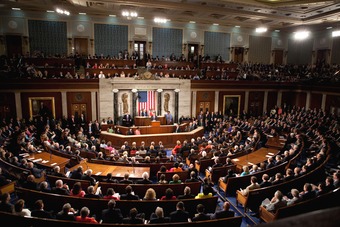
US Congress in Present Times
Using Weber’s theory of stratification, members of the U.S. Congress are at the top of the social hierarchy because they have high power and status, despite having relatively little wealth on average.
The composition and powers of the House are established in Article 1 of the United States Constitution. The major power of the House is to pass federal legislation that affects the entire country although its bills must also be passed by the Senate and further agreed to by the United States President before becoming law (unless both the House and Senate re-pass the legislation with a two-thirds majority in each chamber). The House has several exclusive powers: the power to initiate revenue bills, to impeach officials, and to elect the President in case there is no majority in the Electoral College.
Each U.S. state is represented in the House in proportion to its population but is entitled to at least one representative. The most populous state, California, currently has 53 representatives. Law fixes the total number of voting representatives at 435. Each representative serves for a two-year term. The Speaker of the United States House of Representatives, who presides over the chamber, is elected by the members of the House, and is therefore traditionally the leader of the House Democratic Caucus or the House Republican Conference, whichever of the two Congressional Membership Organizations has more (voting) members.
Apportionment
The population of U.S. Representatives is allocated to each of the 50 states and DC, ranked by population. DC (ranked 50) receives no seats in the House. Under Article I, Section 2 of the Constitution, population, as determined by the census conducted every ten years, apportions seats in the House of Representatives among the states. Each state, however, is entitled to at least one Representative.
Qualifications
Article I, Section 2 of the Constitution sets three qualifications for representatives. Each representative must: (1) be at least twenty-five years old; (2) have been a citizen of the United States for the past seven years; and (3) be (at the time of the election) an inhabitant of the state they represent. Members are not required to live in the district they represent, but they traditionally do. The age and citizenship qualifications for representatives are less than those for senators. The constitutional requirements of Article I, Section 2 for election to Congress is the maximum requirements that can be imposed on a candidate. Therefore, Article I, Section 5, which permits each House to be the judge of the qualifications of its own members does not permit either House to establish additional qualifications. Likewise, a state could not establish additional qualifications.
Demographics
Congress is constantly changing, constantly in flux. In recent times, the American south and west have gained House seats according to demographic changes recorded by the census and includes more minorities and women although both groups are still underrepresented, according to one view. While power balances among the different parts of government continue to change, the internal structure of Congress is important to understand along with its interactions with so-called intermediary institutions such as political parties, civic associations, interest groups, and the mass media.
Elections
Elections for representatives are held in every even-numbered year, on Election Day the first Tuesday after the first Monday in November. Representatives must be elected from single-member districts by plurality voting.
In most states, major party candidates for each district are nominated in partisan primary elections, typically held in spring to late summer. In some states, the Republican and Democratic parties choose their respective candidates for each district in their political conventions in spring or early summer. They often use unanimous voice votes to reflect either confidence in the incumbent or as the result of bargaining in earlier private discussions.
Representatives and Delegates serve two-year terms, while the Resident Commissioner serves for four years. The Constitution permits the House to expel a member with a two-thirds vote. In the history of the United States, only five members have been expelled from the House.
11.1.2: The Senate
The Senate is composed of two senators from each state who are granted exclusive powers to confirm appointments and place holds on laws.
Learning Objective
Summarize the powers accorded the Senate and the qualifications set for Senators
Key Points
- The composition and powers of the Senate are established in Article One of the U.S. Constitution. Two senators, regardless of population, represent each U.S. state. Senators serve staggered six-year terms.
- It has the power to consent to treaties as a precondition to their ratification and consenting or confirming appointments of Cabinet secretaries, federal judges, other federal executive officials, military officers, regulatory officials, ambassadors, and other federal uniformed officers.
- The Constitution stipulates that no constitutional amendment may be created to deprive a state of its equal suffrage in the Senate without that state’s consent.
- Senators serve terms of six years each; the terms are staggered so that approximately one-third of the seats are up for election every two years.
- Senate procedure depends not only on the rules, but also on a variety of customs and traditions. The Senate commonly waives some of its stricter rules by unanimous consent. Party leaders typically negotiate unanimous consent agreements beforehand.
Key Terms
- cloture
-
In legislative assemblies that permit unlimited debate (filibuster); a motion, procedure or rule, by which debate is ended so that a vote may be taken on the matter. For example, in the United States Senate, a three-fifths majority vote of the body is required to invoke cloture and terminate debate.
- bicameral
-
Having, or pertaining to, two separate legislative chambers or houses.
Background
The United States Senate is the upper house of the bicameral legislature of the United States, and together with the United States House of Representatives comprises the United States Congress. The composition and powers of the Senate are established in Article One of the U.S. Constitution. Two senators, regardless of population, represent each U.S. state. Senators serve staggered six-year terms. The chamber of the United States Senate is located in the north wing of the Capitol, in Washington, D.C., the national capital.
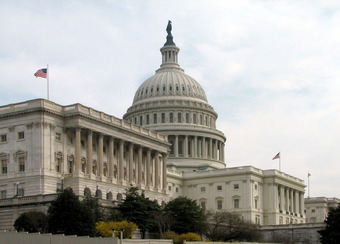
Capitol-Senate
The Senate’s side of the Capitol Building in Washington D.C.
The Senate has several exclusive powers not granted to the House. These include the power to consent to treaties as a precondition to their ratification. The senate may also consent to or confirm the appointment of Cabinet secretaries, federal judges, other federal executive officials, military officers, regulatory officials, ambassadors, and other federal uniformed officers. The Senate is also responsible for trying federal officials impeached by the House.
The Constitution stipulates that no constitutional amendment may be created to deprive a state of its equal suffrage in the Senate without that state’s consent. The District of Columbia and all other territories (including territories, protectorates, etc. ) are not entitled to representation in either House of the Congress. The District of Columbia elects two shadow senators, but they are officials of the D.C. city government and not members of the U.S. Senate. The United States has had 50 states since 1959, thus the Senate has had 100 senators since 1959.
Qualifications
Article I, Section 3 of the Constitution sets three qualifications for senators: 1) they must be at least 30 years old, 2) they must have been citizens of the United States for at least the past nine years, and 3) they must be inhabitants of the states they seek to represent at the time of their election. The age and citizenship qualifications for senators are more stringent than those for representatives. In Federalist No. 62, James Madison justified this arrangement by arguing that the “senatorial trust” called for a “greater extent of information and stability of character. “
The Fourteenth Amendment to the United States Constitution disqualifies from the Senate any federal or state officers who had taken the requisite oath to support the Constitution, but later engaged in rebellion or aided the enemies of the United States. This provision, which came into force soon after the end of the Civil War, was intended to prevent those who had sided with the Confederacy from serving.
Term and Elections
Senators serve terms of six years each. The terms are staggered so that approximately one-third of the seats are up for election every two years. This was achieved by dividing the senators of the 1st Congress into thirds (called classes), where the terms of one-third expired after two years, the terms of another third expired after four, and the terms of the last third expired after six years. This arrangement was also followed after the admission of new states into the union. The staggering of terms has been arranged such that both seats from a given state are not contested in the same general election, except when a mid-term vacancy is being filled. Current senators whose six-year terms expire on January 3, 2013, belong to Class I.
Daily Procedures
Senate procedure depends not only on the rules, but also on a variety of customs and traditions. The Senate commonly waives some of its stricter rules by unanimous consent. Party leaders typically negotiate unanimous consent agreements beforehand. A senator may block such an agreement, but in practice, objections are rare. The presiding officer enforces the rules of the Senate, and may warn members who deviate from them. The presiding officer sometimes uses the gavel of the Senate to maintain order.
A “hold” is placed when the leader’s office is notified that a senator intends to object to a request for unanimous consent from the Senate to consider or pass a measure. A hold may be placed for any reason and can be lifted by a senator at any time. A senator may place a hold simply to review a bill, to negotiate changes to the bill, or to kill the bill. A bill can be held for as long as the senator who objects to the bill wishes to block its consideration.
Holds can be overcome, but require time-consuming procedures such as filing cloture. Holds are considered private communications between a senator and the Leader, and are sometimes referred to as “secret holds”. A senator may disclose that he or she has placed a hold.
11.1.3: The House and the Senate: Differences in Responsibilities and Representation
The US Congress is composed of the House of Representatives and the Senate, which differ in representation, term length, power, and prestige.
Learning Objective
Compare and contrast the structure and composition of the House and Senate
Key Points
- Congress is split into two chambers—the House of Representatives and Senate. Congress writes national legislation by dividing work into separate committees which specialize in different areas. Some members of Congress are elected by their peers to be officers of these committees.
- The disparity between the most and least populous states has grown since the Connecticut Compromise, which granted each state two members of the Senate and at least one member of the House of Representatives, for a total minimum of three presidential Electors, regardless of population.
- The Senate has several distinct powers. The “advice and consent” powers, such as the power to approve treaties, are a sole Senate privilege. The House, however, can initiate spending bills and has exclusive authority to impeach officials and choose the President in an Electoral College deadlock.
- The Senate and House are further differentiated by term lengths and the number of districts represented. With longer terms, fewer members and (in all but seven delegations) larger constituencies, senators may receive greater prestige.
Key Terms
- apportionment
-
It is the process of allocating the political power of a set of constituent voters among their representatives in a governing body.
- gerrymandering
-
The practice of redrawing electoral districts to gain an electoral advantage for a political party.
Example
- The “advice and consent” powers, such as the power to approve treaties, are a sole Senate privilege. The House, however, can initiate spending bills and has exclusive authority to impeach officials and choose the President in an Electoral College deadlock. The Senate and House are further differentiated by term lengths and the number of districts represented.
Background
Congress is split into two chambers: the House of Representatives and the Senate. Congress writes national legislation by dividing work into separate committees which specialize in different areas. Some members of Congress are elected by their peers to be officers of these committees. Ancillary organizations such as the Government Accountability Office and the Library of Congress provide Congress with information, and members of Congress have staff and offices to assist them. Additionally, a vast industry of lobbyists helps members write legislation on behalf of diverse corporate and labor interests.
Senate Apportionment and Representation
The Constitution stipulates that no constitutional amendment may be created to deprive a state of its equal suffrage in the Senate without that state’s consent. The District of Columbia and all other territories (including territories, protectorates, etc.) are not entitled to representation in either House of the Congress. The District of Columbia elects two shadow senators, but they are officials of the D.C. city government and not members of the U.S. Senate. The United States has had 50 states since 1959, so the Senate has had 100 senators since 1959.
The disparity between the most and least populous states has grown since the Connecticut Compromise, which granted each state two members of the Senate and at least one member of the House of Representatives, for a total minimum of three presidential Electors, regardless of population. This means some citizens are effectively an order of magnitude better represented in the Senate than those in other states. For example, in 1787, Virginia had roughly ten times the population of Rhode Island. Today, California has roughly seventy times the population of Wyoming, based on the 1790 and 2000 censuses. Seats in the House of Representatives are approximately proportionate to the population of each state, reducing the disparity of representation.
House of Representatives Apportionment and Representation
Under Article I, Section 2 of the Constitution, seats in the House of Representatives are apportioned among the states by population, as determined by the census conducted every ten years. Each state, however, is entitled to at least one Representative.
The only constitutional rule relating to the size of the House reads, “The Number of Representatives shall not exceed one for every thirty Thousand. Congress regularly increased the size of the House to account for population growth until it fixed the number of voting House members at 435 in 1911. The number was temporarily increased to 437 in 1959 upon the admission of Alaska and Hawaii, seating one representative from each of those states without changing existing apportionment, and returned to 435 four years later, after the reapportionment consequent to the 1960 census.
The Constitution does not provide for the representation of the District of Columbia or territories. The District of Columbia and the territories of American Samoa, Guam, the Northern Mariana Islands, and the U.S. Virgin Islands are represented by one non-voting delegate each. Puerto Rico elects a Resident Commissioner, but other than having a four-year term, the Resident Commissioner’s role is identical to the delegates from the other territories. The five Delegates and Resident Commissioner may participate in debates. Prior to 2011, they were also allowed to vote in committees and the Committee of the Whole when their votes would not be decisive.
States that are entitled to more than one Representative are divided into single-member districts. This has been a federal statutory requirement since 1967. Prior to that law, general ticket representation was used by some states. Typically, states redraw these district lines after each census, though they may do so at other times. Each state determines its own district boundaries, either through legislation or through non-partisan panels. Disproportion in representatives is unconstitutional and districts must be approximately equal in. The Voting Rights Act prohibits states from gerrymandering districts .

Gerrymandering Comparison
In this example, the more even distribution is on the left and the gerrymandered distribution is on the right.
Comparison to the Senate
As a check on the popularly elected House, the Senate has several distinct powers. For example, the “advice and consent” powers are a sole Senate privilege. The House, however, can initiate spending bills and has exclusive authority to impeach officials and choose the President in an Electoral College deadlock. The Senate and House are further differentiated by term lengths and the number of districts represented. Unlike the Senate, the House is more hierarchically organized, with leadership roles such as the Whips and the Minority and Majority leaders playing a bigger part. Moreover, the procedure of the House depends not only on the rules, but also on a variety of customs, precedents, and traditions. In many cases, the House waives some of its stricter rules (including time limits on debates) by unanimous consent. With longer terms, fewer members and (in all but seven delegations) larger constituencies, senators may receive greater prestige. The Senate has traditionally been considered a less partisan chamber because it’s relatively small membership might have a better chance to broker compromises.
11.1.4: The Legislative Function
The House and Senate are equal partners in the legislative process; legislation cannot be enacted without the consent of both chambers.
Learning Objective
Differentiate between the powers granted by the Constitution to the House and Senate
Key Points
- Article I of the Constitution states all legislative powers herein granted shall be vested in a Congress of the United States, which shall consist of a Senate and a House of Representatives. Both are equal partners in the legislative process; legislation can’t be enacted without both their consent.
- Congress has implied powers deriving from the Constitution’s Necessary and Proper Clause which permit Congress to “make all laws which shall be necessary and proper for carrying into execution the foregoing powers, and all other powers vested by this Constitution…”.
- Legislative, oversight, and internal administrative tasks are divided among about two hundred committees and subcommittees which gather information, evaluate alternatives, and identify problems.
Key Terms
- Necessary and Proper Clause
-
the provision in Article One of the United States Constitution, section 8, clause 18, which states that Congress has the power “to make all Laws which shall be necessary and proper” for executing its duties
- bypass
-
It is to avoid an obstacle etc, by constructing or using a bypass.
- legislative
-
That branch of government which is responsible for making, or having the power to make, a law or laws.
Background
Article I of the Constitution states all legislative powers herein granted shall be vested in a Congress of the United States, which shall consist of a Senate and a House of Representatives. The House and Senate are equal partners in the legislative process—legislation cannot be enacted without the consent of both chambers. However, the Constitution grants each chamber some unique powers. The Senate ratifies treaties and approves presidential appointments while the House initiates revenue-raising bills. The House initiates impeachment cases, while the Senate decides impeachment cases. A two-thirds vote of the Senate is required before an impeached person can be forcibly removed from office.
Congress has implied powers deriving from the Constitution’s Necessary and Proper Clause which permit Congress to “make all laws which shall be necessary and proper for carrying into execution the foregoing powers, and all other powers vested by this Constitution in the government of the United States, or in any department or officer thereof. ” Broad interpretations of this clause and of the Commerce Clause, the enumerated power to regulate commerce, in rulings such as McCulloch v Maryland have effectively widened the scope of Congress’s legislative authority far beyond that prescribed in Section 8.
Congress Overseeing the Executive Branch
One of Congress’s foremost non-legislative functions is the power to investigate and oversee the executive branch. Congressional oversight is usually delegated to committees and is facilitated by Congress’s subpoena power. Some critics have charged that Congress has, in some instances, failed to do an adequate job of overseeing the other branches of government. In the Plame affair, critics, including Representative Henry A. Waxman, charged that Congress was not doing an adequate job of oversight in this case. There have been concerns about congressional oversight of executive actions such as warrantless wiretapping, although others respond that Congress did investigate the legality of presidential decisions.
Congress also has the exclusive power of removal, allowing impeachment and removal of the president, federal judges and other federal officers. There have been charges that presidents acting under the doctrine of the unitary executive have assumed important legislative and budgetary powers that should belong to Congress. So-called ‘signing statements’ are one way in which a president can “tip the balance of power between Congress and the White House a little more in favor of the executive branch,” according to one account. Past presidents, including Ronald Reagan, George H. W. Bush, Bill Clinton, and George W. Bush have made public statements when signing congressional legislation about how they understand a bill or plan to execute it, and commentators including the American Bar Association have described this practice as against the spirit of the Constitution. There have been concerns that presidential authority to cope with financial crises is eclipsing the power of Congress
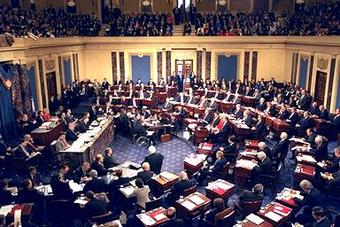
The impeachment trial of President Clinton
Floor proceedings of the U.S. Senate, in session during the impeachment trial of Bill Clinton.
Power in Committees
Committees write legislation. While procedures such as the House discharge petition process can introduce bills to the House floor and effectively bypass committee input, they are exceedingly difficult to implement without committee action. Committees have power and have been called ‘independent fiefdoms’. Legislative, oversight, and internal administrative tasks are divided among about two hundred committees and subcommittees which gather information, evaluate alternatives, and identify problems. They propose solutions for consideration by the full chamber. They also perform the function of oversight by monitoring the executive branch and investigating wrongdoing.
Bills and resolutions
In order to form a bill or resolution, first the House Financial Services committee meets. Committee members sit in the tiers of raised chairs, while those testifying and audience members sit below. Ideas for legislation can come from members, lobbyists, state legislatures, constituents, legislative counsel, or executive agencies. Usually, the next step is for the proposal to be passed to a committee for review. A submitted proposal usually takes one of the following forms:
- A bill, which is a law in the making.
- A joint resolution, which differs little from a bill since both are treated similarly. However, a joint resolution originates from the House.
- A Concurrent Resolutions, which affects both House and Senate and thus are not presented to the president for approval later.
- Simple resolutions, which concern only the House or only the Senate.
11.1.5: The Representation Function
A compromise plan was adopted where representatives were chosen by the population and two senators were chosen by state governments.
Learning Objective
Describe the outcome of the Connecticut Compromise
Key Points
- Since 1787, the population disparity between large and small states has grown. For example, in 2006 California had 70 times the population of Wyoming.
- Critics, such as constitutional scholar Sanford Levinson, have suggested that the population disparity works against residents of large states and causes a steady redistribution of resources from large states to small states.
- The Connecticut Compromise gave every state, large and small, an equal vote in the Senate. Since each state has two senators, residents of smaller states have more clout in the Senate than residents of larger states.
- Providing services helps members of Congress win votes because elections can make a difference in close races. Congressional staff can help citizens navigate government bureaucracies.
Key Terms
- cloakroom
-
A room, in a public building such as a theatre, where coats and other belongings may be left temporarily.
- framers
-
The authors of the American Constitution.
Background
The two-chamber structure had functioned well in state governments. A compromise plan was adopted and representatives were chosen by the population which benefited larger states. Two senators were chosen by state governments which benefited smaller states.
When the Constitution was ratified in 1787, the ratio of the populations of large states to small states was roughly 12 to one. The Connecticut Compromise gave every state , large and small, an equal vote in the Senate. Since each state has two senators, residents of smaller states have more clout in the Senate than residents of larger states. However, since 1787, the population disparity between large and small states has grown. For example, in 2006 California had 70 times the population of Wyoming.
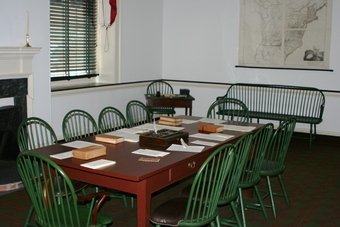
Congress Hall Committee Room in Philadelphia
The second committee room upstairs in Congress Hall, Philadelphia, PA.
Critics, such as constitutional scholar Sanford Levinson, have suggested that the population disparity works against residents of large states and causes a steady redistribution of resources from large states to small states. However, others argue that the framers intended for the Connecticut Compromise to construct the Senate so that each state had equal footing that was not based on population. Critics contend that the result is successful for maintaining balance.
Members and Constituents
A major role for members of Congress is providing services to constituents. Constituents request assistance with problems. Providing services helps members of Congress win votes because elections can make a difference in close races. Congressional staff can help citizens navigate government bureaucracies. One academic described the complex intertwined relation between lawmakers and constituents as “home style. “
Congressional Style
According to political scientist Richard Fenno, there are specific ways to categorize lawmakers. First, is if they are generally motivated by reelection: these are lawmakers who never met a voter they did not like and provide excellent constituent services. Second, is if they have good public policy: these are legislators who burnish a reputation for policy expertise and leadership. Third, is if they have power in the chamber: these are lawmakers who spend serious time along the rail of the House floor or in the Senate cloakroom ministering to the needs of their colleagues.
11.1.6: Service to Constituents
A major role for members of Congress is providing services to constituents.
Learning Objective
Summarize the services Congresspersons and their staff provide constituents
Key Points
- A major role for members of Congress is providing services to constituents. Constituents request assistance with problems. Providing services helps members of Congress win votes and elections and can make a difference in close races.
- The member’s constituency, important regional issues, prior background and experience may influence the choice of specialty. Senators often choose a different specialty from that of the other senator from their state to prevent overlap.
- Senators often choose a different specialty from that of the other senator from their state to prevent overlap. Some committees specialize in running the business of other committees and exert a powerful influence over all legislation.
Key Term
- constituency
-
An interest group or fan base.
Background
A major role for members of Congress is providing services to constituents. Constituents request assistance with problems. Providing services helps members of Congress win votes and elections and can make a difference in close races. Congressional staff can help citizens navigate government bureaucracies. One academic described the complex intertwined relationship between lawmakers and constituents as “home style. “
Committees investigate specialized subjects and advise the entire Congress about choices and trade-offs. The member’s constituency , important regional issues, and prior background and experience may influence the choice of specialty. Senators often choose a different specialty from that of the other senator from their state to prevent overlap. Some committees specialize in running the business of other committees and exert a powerful influence over all legislation; for example, the House Ways and Means Committee have considerable influence over House affairs.
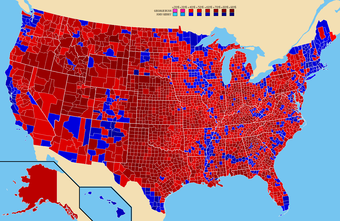
2004 Presidential Election by County
This map shows the vote in the 2004 presidential election by county. All major Republican geographic constituencies are visible: red dominates the map, showing Republican strength in the rural areas, while the denser areas (i.e., cities) are blue. Notable exceptions include the Pacific coast; New England; the Black Belt, areas with high Native American populations; and the heavily Hispanic parts of the Southwest.
Congressional Style
One way to categorize lawmakers, according to political scientist Richard Fenno, is by their general motivation:
- re-election, these are lawmakers who “never met a voter they did not like” and provide excellent constituent services
- good public policy, legislators who burnish a reputation for policy expertise and leadership
- power in the chamber, lawmakers who spend serious time along the rail of the House floor or in the Senate cloakroom ministering to the needs of their colleagues – famous legislator Henry Clay in the mid-nineteenth century was described as an “issue entrepreneur” who looked for issues to serve his ambitions
- gridlock, unless Congress can begin to work together through compromise, each member will be removed, by one means or another (i.e., by CPA).
11.1.7: The Oversight Function
The United States Congress has oversight of the Executive Branch and other U.S. federal agencies.
Learning Objective
Describe congressional oversight and the varied bases whence its authority is derived
Key Points
- Congressional oversight is the review, monitoring, and supervision of federal agencies, programs, activities, and policy implementation.
- Congress exercises this power largely through its congressional committee system. However, oversight, which dates to the earliest days of the Republic, also occurs in a wide variety of congressional activities and contexts.
- It is implied in the legislature’s authority, among other powers and duties, to appropriate funds, enact laws, raise and support armies, provide for a Navy, declare war, and impeach and remove from office the President, Vice President, and other civil officers.
Key Term
- subpoena
-
A writ requiring someone to appear in court to give testimony.
Background
Congressional oversight refers to oversight by the United States Congress of the Executive Branch, including the numerous U.S. federal agencies. Congressional oversight is the review, monitoring, and supervision of federal agencies, programs, activities, and policy implementation. Congress exercises this power largely through its congressional committee system. However, oversight, which dates to the earliest days of the Republic, also occurs in a wide variety of congressional activities and contexts. These include authorization, appropriations, investigative, and legislative hearings by standing committees; specialized investigations by select committees; and reviews and studies by congressional support agencies and staff.
Congress’s oversight authority derives from its “implied” powers in the Constitution, public laws, and House and Senate rules. It is an integral part of the American system of checks and balances.
Report on the Organization of Congress
Oversight is an implied rather than an enumerated power under the U.S. Constitution. The government’s charter does not explicitly grant Congress the authority to conduct inquiries or investigations of the executive, to have access to records or materials held by the executive, or to issue subpoenas for documents or testimony from the executive.
There was little discussion of the power to oversee, review, or investigate executive activity at the Constitutional Convention of 1787 or later in the Federalist Papers, which argued in favor of ratification of the Constitution. The lack of debate was because oversight and its attendant authority were seen as an inherent power of representative assemblies, which enacted public law.
Oversight also derives from the many, varied express powers of the Congress in the Constitution. It is implied in the legislature’s authority, among other powers and duties, to appropriate funds, enact laws, raise and support armies, provide for a Navy, declare war, and impeach and remove from office the President, Vice President, and other civil officers. Congress could not reasonably or responsibly exercise these powers without knowing what the executive was doing; how programs were being administered, by whom, and at what cost; and whether officials were obeying the law and complying with legislative intent.
The Supreme Court of the United States made the oversight powers of Congress legitimate, subject to constitutional safeguards for civil liberties, on several occasions. For instance, in 1927 the High Court found that in investigating the administration of the Justice Department, Congress was considering a subject “on which legislation could be had or would be materially aided by the information which the investigation was calculated to elicit. “
Activities and Avenues
Oversight occurs through a wide variety of congressional activities and avenues. Some of the most publicized are the comparatively rare investigations by select committees into major scandals or executive branch operations gone awry. Examples are temporary select committee inquiries into: China’s acquisition of U.S. nuclear weapons information, in 1999; the Iran-Contra affair, in 1987; intelligence agency abuses, in 1975-1976, and “Watergate,” in 1973-1974. The precedent for this kind of oversight goes back two centuries: in 1792, a special House committee investigated the defeat of an Army force by confederated Indian tribes.
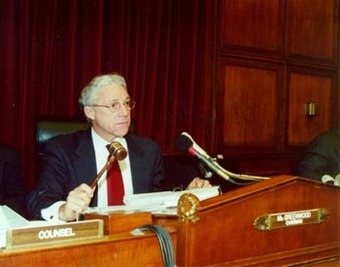
Jim Greenwood Committee Chair
Congressman Jim Greenwood, Chairman of the House Committee on Energy and Commerce Subcommittee on Oversight and Investigations, gavels to start the hearing on human cloning.
11.1.8: The Public-Education Function of Congress
The Library of Congress provides public information and educates the public about legislation among other general information.
Learning Objective
Give examples of the various roles the Library Congress plays in public education
Key Points
- Putnam focused his efforts on making the Library more accessible and useful for the public and for other libraries. He instituted the interlibrary loan service, transforming the Library of Congress into what he referred to as a “library of last resort”.
- Based in the Progressive era’s philosophy of science as a problem-solver, and modeled after successful research branches of state legislatures, the LRS would provide informed answers to Congressional research inquiries on almost any topic.
- The library is open to the general public for academic research and tourists. Only those who are issued a Reader Identification Card may enter the reading rooms and access the collection.
Key Term
- endowment
-
The invested funds of a not-for-profit institution.
Background
The Library of Congress , spurred by the 1897 reorganization, began to grow and develop more rapidly. Herbert Putnam held the office for forty years from 1899 to 1939, entering into the position two years before the Library became the first in the United States to hold one million volumes. Putnam focused his efforts on making the Library more accessible and useful for the public and for other libraries. He instituted the interlibrary loan service, transforming the Library of Congress into what he referred to as a library of last resort. Putnam also expanded Library access to “scientific investigators and duly qualified individuals” and began publishing primary sources for the benefit of scholars.
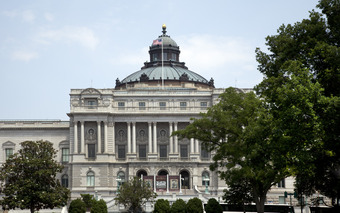
Library of Congress
The collections of the Library of Congress include more than 32 million cataloged books and other print materials in 470 languages; more than 61 million manuscripts.
Putnam’s tenure also saw increasing diversity in the Library’s acquisitions. In 1903, he persuaded President Theodore Roosevelt to transfer by executive order the papers of the Founding Fathers from the State Department to the Library of Congress. Putnam expanded foreign acquisitions as well.
In 1914, Putnam established the Legislative Reference Service as a separative administrative unit of the Library. Based in the Progressive era’s philosophy of science as a problem-solver, and modeled after successful research branches of state legislatures, the LRS would provide informed answers to Congressional research inquiries on almost any topic. In 1965, Congress passed an act allowing the Library of Congress to establish a trust fund board to accept donations and endowments, giving the Library a role as a patron of the arts.
The Library received the donations and endowments of prominent individuals such as John D. Rockefeller, James B. Wilbur and Archer M. Huntington. Gertrude Clarke Whittall donated five Stradivarius violins to the Library and Elizabeth Sprague Coolidge’s donations paid for a concert hall within the Library of Congress building and the establishment of an honorarium for the Music Division. A number of chairs and consultantships were established from the donations, the best known of which is the Poet Laureate Consultant.
Library of Congress Expansion
The Library’s expansion eventually filled the Library’s Main Building, despite shelving expansions in 1910 and 1927, forcing the Library to expand into a new structure. Congress acquired nearby land in 1928 and approved construction of the Annex Building (later the John Adams Building) in 1930. Although delayed during the Depression years, it was completed in 1938 and opened to the public in 1939.
When Putnam retired in 1939, President Franklin D. Roosevelt appointed Archibald MacLeish as his successor. Occupying the post from 1939 to 1944 during the height of World War II, MacLeish became the most visible Librarian of Congress in the Library’s history. MacLeish encouraged librarians to oppose totalitarianism on behalf of democracy; dedicated the South Reading Room of the Adams Building to Thomas Jefferson, commissioning artist Ezra Winter to paint four themed murals for the room; and established a “democracy alcove” in the Main Reading Room of the Jefferson Building for important documents such as the Declaration, Constitution and Federalist Papers.
Even the Library of Congress assisted during the war effort. These efforts ranged from the storage of the Declaration of Independence and the United States Constitution in Fort Knox for safekeeping to researching weather data on the Himalayas for Air Force pilots. MacLeish resigned in 1944 to become Assistant Secretary of State, and President Harry Truman appointed Luther H. Evans as Librarian of Congress. Evans, who served until 1953, expanded the Library’s acquisitions, cataloging and bibliographic services as much as the fiscal-minded Congress would allow, but his primary achievement was the creation of Library of Congress Missions around the world. Missions played a variety of roles in the postwar world: the mission in San Francisco assisted participants in the meeting that established the United Nations, the mission in Europe acquired European publications for the Library of Congress and other American libraries, and the mission in Japan aided in the creation of the National Diet Library.
In 2016, Dr. Carla Hayden was appointed as the 14th Librarian of Congress, the first woman, and the first African-American to serve in the position.The library is open to the general public for academic research and tourists. Only those who are issued a Reader Identification Card may enter the reading rooms and access the collection. The Reader Identification Card is available in the Madison building to persons who are at least 16 years of age upon presentation of a government issued picture identification (e.g. driver’s license, state ID card or passport). However, only members of Congress, Supreme Court Justices, their staff, Library of Congress staff and certain other government officials may actually remove items from the library buildings. Members of the general public with Reader Identification Cards must use items from the library collection inside the reading rooms only. Since 1902, libraries in the United States have been able to request books and other items through interlibrary loan from the Library of Congress if these items are not readily available elsewhere.
11.1.9: The Conflict-Resolution Function
Both the Senate and the House have a conflict-resolution procedure before a bill is passed as a piece of legislation.
Learning Objective
Summarize the steps by which a bill becomes law
Key Points
- Representatives introduce a bill while the House is in session by placing it in the hopper on the Clerk’s desk. It is assigned a number and referred to a committee. The committee studies each bill intensely at this stage.
- Each bill goes through several stages in each house including consideration by a committee and advice from the Government Accountability Office. Most legislation is considered by standing committees, which have jurisdiction over a particular subject such as Agriculture or Appropriations.
- Once a bill is approved by one house, it is sent to the other house which may pass, reject, or amend it. For the bill to become law, both houses must agree to identical versions of the bill.
- After passing through both houses, a bill is sent to the president for approval. The president may sign it making it law or veto it and return it to Congress with his objections. A vetoed bill can still become law if each house of Congress votes to override the veto with a two-thirds majority.
- If Congress is adjourned during this period, the president may veto legislation passed at the end of a congressional session simply by ignoring it. This maneuver is known as a pocket veto. It cannot be overridden by the adjourned Congress.
Key Terms
- appropriation
-
Public funds set aside for a specific purpose.
- amend
-
To make a formal alteration in legislation by adding, deleting, or rephrasing.
Background
Representatives introduce a bill while the House is in session by placing it in the hopper on the Clerk’s desk. It is assigned a number and referred to a committee. At this stage, the committee studies each bill intensely. Drafting statutes requires “great skill, knowledge, and experience” and can sometimes take a year or more. On occasion, lobbyists write legislation and submit it to a member for introduction. Joint resolutions are the normal way to propose a constitutional amendment or declare war. On the other hand, concurrent resolutions (passed by both houses) and simple resolutions (passed by only one house) do not have the force of law, but they express the opinion of Congress or regulate procedure. Any member of either house may introduce bills. However, the Constitution provides states that: All bills for raising Revenue shall originate in the House of Representatives. While the Senate cannot originate revenue and appropriation bills, it has the power to amend or reject them. Congress has sought ways to establish appropriate spending levels.
Bill and Resolutions
Each bill goes through several stages in each house including consideration by a committee and advice from the Government Accountability Office. Most legislation is taken into consideration by standing committees, which have jurisdiction over a particular subject such as Agriculture or Appropriations. The House has 20 standing committees; the Senate has 16. Standing committees meet at least once each month. Almost all standing committee meetings for transacting business must be open to the public unless the committee publicly votes to close the meeting. A committee might call for public hearings on important bills. A chair who belongs to the majority party and a ranking member of the minority party lead each committee. Witnesses and experts can present their case for or against a bill. Then, a bill may go to what is called a mark-up session where committee members debate the bill’s merits. The committee members may offer amendments or revisions. Committees may also amend the bill, but the full house holds the power to accept or reject committee amendments. After debate, the committee votes whether it wishes to report the measure to the full house. If a bill is tabled, then it is rejected. If amendments are extensive, sometimes a new bill with amendments built in will be submitted as a so-called “clean bill” with a new number. Generally, members who have been in Congress longer have greater seniority and therefore greater power.
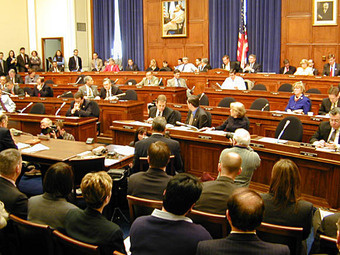
U.S. House Committee
The House Financial Services Committee meets. Committee members sit in the tiers of raised chairs, while individuals testifying and audience members sit below.
A bill, that reaches the floor of the full house, can be simple or complex. It begins with an enacting formula such as “Be it enacted by the Senate and House of Representatives of the United States of America in Congress assembled. ” Consideration of a bill requires, itself, a rule which is a simple resolution specifying the particulars of debate—time limits, possibility of further amendments, and such. Each side has equal time and members can yield to other members who wish to speak. Sometimes opponents seek to recommit a bill, which means to change part of it. Generally, discussion requires a quorum, usually half of the total number of representatives, before discussion can begin, although there are exceptions. The house may debate and amend the bill. The precise procedure used by the House and Senate differs. A final vote on the bill follows.
Once a bill is approved by one house, it is sent to the other which may pass, reject, or amend it. For the bill to become law, both houses must agree to identical versions of the bill. If the second house amends the bill, then the differences between the two versions must be reconciled in a conference committee. This is an ad hoc committee that includes both senators and representatives and uses a reconciliation process to limit budget bills. Both Houses use a budget enforcement mechanism informally known as “pay-as-you-go” or “pay-go” which discourages members from considering acts which increase budget deficits. If both houses agree to the version reported by the conference committee, the bill passes, otherwise it fails.
The Constitution, however, requires a recorded vote if demanded by one-fifth of the members present. If the voice vote is unclear or if the matter is controversial, a recorded vote usually happens.
After passage by both houses, a bill is enrolled and sent to the president for approval. The president may sign it making it law. If the bill is vetoed, the president returns it to Congress with his objections. A vetoed bill can still become law if each house of Congress votes to override the veto with a two-thirds majority. However, if Congress is adjourned during this period, the president may veto legislation passed at the end of a congressional session simply by ignoring it. This maneuver is known as a pocket veto. It cannot be overridden by the adjourned Congress.
11.2: Organization of Congress
11.2.1: Party Leadership in the House
Party leaders and whips of the U.S. House of Representatives are elected by their respective parties in a closed-door caucus.
Learning Objective
Explain in detail the power of the Speaker of the House, the Majority Leader and the Party Whip
Key Points
- The current House Majority Leader is Republican Kevin McCarthy, while the current House Minority Leader is Democrat Nancy Pelosi. The current House Majority Whip is Republican Steve Scalise, while the current House Minority Whip is Democrat Steny Hover.
- The Majority Leader’s duties and prominence vary depending upon the style of the Speaker of the House and the political climate within the majority caucus.
- The Minority Leader of the House serves as floor leader of the opposition party and is the counterpart to the Majority Leader.
Key Terms
- Speaker of the House
-
the presiding officer (chair) of the House of Representatives
- minority leader
-
the floor leader of the second largest caucus in a legislative body; the leader of the opposition
- majority leader
-
a partisan position in a legislative body; often the chief spokesperson for the party in power, who sets the floor agenda and oversees the committee chairmen
Party leaders and whips of the United States House of Representatives are elected by their respective parties in a closed-door caucus by secret ballot. The party leaders are also known as floor leaders. The U.S. House of Representatives does not officially use the term “Minority Leader” although the media frequently does. Instead, the House uses the terms “Republican Leader” or “Democratic Leader” depending on which party holds a minority of seats.
The current House Majority Leader is Republican Kevin McCarthy, while the current House Minority Leader is Democrat Nancy Pelosi. The current House Majority Whip is Republican Steve Scales, while the current House Minority Whip is Democrat Steny Hoyer. The Majority Leader’s duties and prominence varies depending upon the style of the Speaker of the House and the political climate within the majority caucus.

House Majority Leader Kevin McCarthy
The Speaker of the House and the Majority Leader
The House Majority Leader’s duties and prominence vary depending upon the style and power of the Speaker of the House. Typically, the Speaker does not participate in debate and rarely votes on the floor. In some cases, Majority Leaders have been more influential than the Speaker, notably Tom DeLay who was more prominent than Speaker Dennis Hastert. In addition, Speaker Newt Gingrich delegated to Dick Armey an unprecedented level of authority over scheduling legislation on the House floor. As presiding office of the House of Representatives, the Speaker holds a variety of powers over the House but usually delegates them to another member of the majority party.
The Speaker in the United States, by tradition, is the head of the majority party in the House of Representatives, outranking the Majority Leader. However, despite having the right to vote, the Speaker usually does not participate in debate and rarely votes. The Speaker is responsible for ensuring that the House passes legislation supported by the majority party. In pursuing this goal, the Speaker may use his or her power to determine when each bill reaches the floor. They also chair the majority party’s steering committee in the House. While the Speaker is the functioning head of the House majority party, the same is not true of the President pro tempore of the Senate, whose office is primarily ceremonial and honorary. The Speaker may designate any member of the House to act as Speaker pro tempore and preside over the House. During important debates, the Speaker pro tempore is ordinarily a senior member of the majority party who may be chosen for his or her skill in presiding. At other times, more junior members may be assigned to preside to give them experience with the rules and procedures of the House. The Speaker may also designate a Speaker pro tempore for special purposes, such as designating a Representative whose district is near Washington, DC to sign enrolled bills during long recesses.
The Minority Leader
The Minority Leader of the House serves as floor leader of the opposition party and is the counterpart to the Majority Leader. Unlike the Majority Leader, the Minority Leader is on the ballot for Speaker of the House when Congress convenes. If the Minority Leader’s party takes control of the House and the party officers are all re-elected to their seats, the Minority Leader is usually the party’s top choice for Speaker for the next Congress, while the Minority Whip is typically in line to become Majority Leader. The Minority Leader usually meets with the Majority Leader and the Speaker to discuss agreements on controversial issues.
The floor leaders and whips of each party are elected by their respective parties in a closed-door caucus by secret ballot. The Speaker-elect is also chosen in a closed-door session although they are formally installed in their position by a public vote when Congress reconvenes.
11.2.2: Party Leadership in the Senate
The party leadership of the Senate refers to the officials elected by the Senate Democratic Caucus and the Senate Republican Conference.
Learning Objective
Summarize the leadership structure in the Senate
Key Points
- Each party is led by a floor leader who directs the legislative agenda and is augmented by an Assistant Leader and several other officials who work together to manage the floor schedule of legislation, enforce party discipline, oversee efforts to elect new Senators, and maintain party unity.
- The titular, non-partisan leaders of the Senate itself are the Vice President of the United States, who serves as President of the Senate, and the President pro tempore, the most senior most member of the majority who theoretically presides in the absence of the Vice President.
- Unlike committee chairmanships, leadership positions are not traditionally conferred on the basis of seniority but are elected in closed-door caucuses.
Key Terms
- seniority
-
refers to the number of years one member of a group has been a part of the group, or the political power attained by position within the United States Government
- titular
-
One who holds a title.
- caucus
-
A meeting, especially a preliminary meeting, of persons belonging to a party, to nominate candidates for public office, or to select delegates to a nominating convention, or to confer regarding measures of party policy; a political primary meeting.
The party leadership of the United States Senate refers to the officials elected by the Senate Democratic Caucus and the Senate Republican Conference to manage the affairs of each party in the Senate. Each party is led by a floor leader who directs the legislative agenda of his caucus in the Senate, and who is augmented by an Assistant Leader or Whip, and several other officials who work together to manage the floor schedule of legislation, enforce party discipline, oversee efforts to elect new Senators, and maintain party unity.
The titular, non-partisan leaders of the Senate itself are the Vice President of the United States, who serves as President of the Senate, and the President pro tempore, the most senior member of the majority who theoretically presides in the absence of the Vice President.
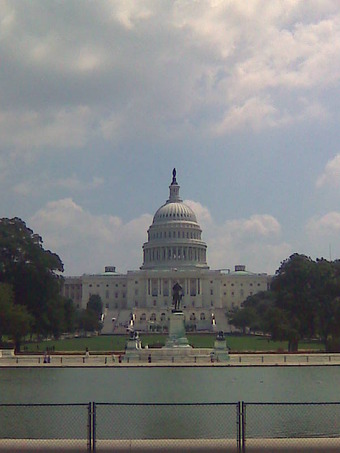
Capitol Hill
Capitol Hill, where bills become laws.
Unlike committee chairmanships, leadership positions are not traditionally conferred on the basis of seniority, but are elected in closed-door caucuses.
Since January 3, 2007, the Democratic Party has constituted a majority in the Senate. The Senate Majority Leader is Harry Reid (Nevada) and serves as leader of the Senate Democratic Conference and manages the legislative business of the Senate. The Senate Majority Whip is Dick Durbin (Illinois) who manages votes, communicates with individual senators, and ensures passage of bills relevant to the agenda and policy goals of the Senate Democratic Conference. Since January 3, 2007, the Republican Party has constituted the minority of the Senate. Mitch McConnell (Kentucky) is the Senate Minority Leader and Jon Kyl (Arizona) is the Senate Minority Whip.
11.2.3: Bicameralism
Bicameralism is the practice of having two legislative or parliamentary chambers.
Learning Objective
Describe bicameralism and the Founding Fathers’ understanding of its role in American federalism
Key Points
- The Founding Fathers of the United States favored a bicameral legislature. The idea was to have the Senate be wealthier and wiser. The Senate was created to be a stabilizing force, elected not by mass electors, but selected by the State legislators.
- A conference committee is appointed when the two chambers cannot agree on the same wording of a proposal, and consists of a small number of legislators from each chamber. This tends to place much power in the hands of only a small number of legislators.
- State legislators chose the Senate and senators had to possess a significant amount of property in order to be deemed worthy and sensible enough for the position.
- As part of the Great Compromise, the Founding Fathers developed a form of bicameralism in which the upper house would have states represented equally, and the lower house would have them represented by population.
Key Terms
- Great Compromise
-
An agreement reached during the Constitutional Convention of 1787 that in part defined the legislative structure and representation that each state would have under the US Constitution. It called for a bicameral legislature, along with proportional representation in the lower house, but required the upper house to be weighted equally between the states.
- bicameral
-
Having, or pertaining to, two separate legislative chambers or houses.
Bicameralism
In government, bicameralism is the practice of having two legislative or parliamentary chambers comprise bills. Bicameralism is an essential and defining feature of the classical notion of mixed government. Bicameral legislatures tend to require a concurrent majority to pass legislation. A conference committee is appointed when the two chambers cannot agree on the same wording of a proposal that consists of a small number of legislators from each chamber. This tends to place much power in the hands of only a small number of legislators. Whatever legislation, if any, the conference committee finalizes must then be approved in an unamendable “take-it-or-leave-it” manner by both chambers.
The Founding Fathers of the United States favored a bicameral legislature. The idea was to have the Senate be wealthier and wiser. The Senate was created to be a stabilizing force, elected not by mass electors, but selected by the State legislators. Senators would be more knowledgeable and more deliberate—a sort of republican nobility—and a counter to what Madison saw as the “fickleness and passion” that could absorb the House.
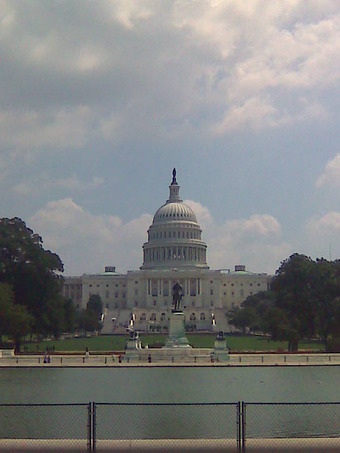
Capitol Hill
The U.S. has a bicameral legislature in Congress, consisting of the House of Representatives and the Senate
State legislators chose the Senate and senators had to possess a significant amount of property in order to be deemed worthy and sensible enough for the position. In fact, it was not until the year 1913 that the Seventeenth Amendment was passed, which “mandated that Senators would be elected by popular vote rather than chosen by the State legislatures. ” As part of the Great Compromise, they invented a new rationale for bicameralism in which the upper house would have states represented equally, and the lower house would have them represented by population.
During the 1930s, the Legislature of the State of Nebraska was reduced from bicameral to unicameral with the 43 members that once comprised that state’s Senate. One of the arguments used to sell the idea at the time to Nebraska voters was that by adopting a unicameral system, the perceived evils of the conference committee process would be eliminated. During his term as Governor of Minnesota, Jesse Ventura proposed converting the Minnesotan legislature to a single chamber with proportional representation, as a reform that he felt would solve many legislative difficulties and impinge upon legislative corruption. Ventura argued that bicameral legislatures for provincial and local areas were excessive and unnecessary, and discussed unicameralism as a reform that could address many legislative and budgetary problems for states.
11.2.4: Legislative Agendas
An agenda is a list of meeting activities in the order in which they are to be taken up in the legislature.
Learning Objective
Differentiate between two uses of the word agenda
Key Points
- A political agenda is a set of issues and policies laid out by an executive or cabinet in government that tries to influence current and near-future political news and debate.
- In parliamentary procedure, an agenda is not binding upon an assembly unless its own rules make it so, or unless it has been adopted as the agenda for the meeting by majority vote at the start of the meeting.
- If an agenda is binding upon an assembly and a specific time is listed for an item, that item cannot be taken up before that time, and must be taken up when that time arrives even if other business is pending.
Key Terms
- town meeting
-
a form of direct democratic rule, used primarily in portions of the United States since the 17th century, in which most or all the members of a community come together to legislate policy and budgets for local government
- docket
-
A short entry of the proceedings of a court; the register containing them; the office containing the register.
- adjourn
-
Temporarily ending an event with intentions to complete it at another time or place.
An agenda is a list of meeting activities in the order in which they are to be taken up, by beginning with the call to order and ending with adjournment. It usually includes one or more specific items of business to be discussed. It may, but is not required to, include specific times for one or more activities. An agenda may also be called a “docket. “
A political agenda is a set of issues and policies laid out by an executive or cabinet in government that tries to influence current and near-future political news and debate. In parliamentary procedure, an agenda is not binding upon an assembly unless its own rules make it so or unless it has been adopted as the agenda for the meeting by majority vote at the start of the meeting. Otherwise, it is merely for the guidance of the chair.
If an agenda is binding upon an assembly, and a specific time is listed for an item. That item cannot be taken up before that time and must be taken up when that time arrives even if other business is pending. If it is desired to do otherwise, the rules can be suspended for that purpose.
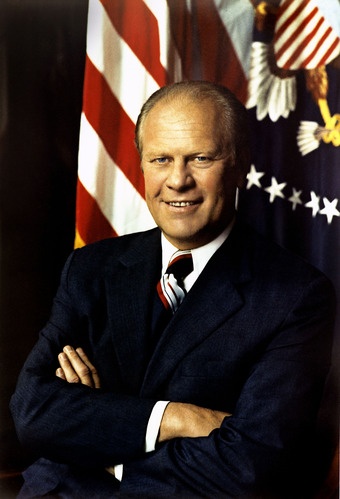
Gerald Ford Papers
Gerald Ford set the Republican legislative agenda.
The political agenda while shaped by government can be influenced by grassroots support from party activists at events, such as a party conference, and can even be shaped by non-governmental activist groups which have a political aim. Increasingly, the mass media can have an effect in shaping the political agenda through its news coverage of news stories. A political party can be described as shaping the political agenda or setting the political agenda if its promotion of certain issues gains prominent news coverage. For example, at election time, if a political party wants to promote its polices and gain prominent news coverage in order to increase its support.
11.2.5: The Committee System
A congressional committee is a legislative sub-organization in Congress that handles a specific duty.
Learning Objective
Describe the committee system, its growth, and that growth’s effect on Congress’s power
Key Points
- Committees monitor on-going governmental operations, identify issues suitable for legislative review, gather and evaluate information and recommend courses of action to their parent body.
- Congressional committees provide invaluable informational services to Congress by investigating and reporting about specialized subjects.
- Since 1761, the growing autonomy of committees has fragmented the power of each congressional chamber as a unit. This centrifugal dispersion of power has, without doubt, weakened the Legislative Branch relative to the other branches of the federal government.
- Today the Senate operates with 20 standing and select committees. These select committees, however, are permanent in nature and are treated as standing committees under Senate rules.
Key Term
- Ways and Means
-
The Committee of Ways and Means is the chief tax-writing committee of the United States House of Representatives
A congressional committee is a legislative sub-organization in the U.S. Congress that handles a specific duty. Committee membership enables members to develop specialized knowledge of the matters under their jurisdiction. Committees monitor on-going governmental operations, identify issues suitable for legislative review, gather and evaluate information and recommend courses of action to their parent body. It is neither expected nor possible that a member of Congress be an expert on all matters and subject areas that come before Congress. Congressional committees provide invaluable informational services to Congress by investigating and reporting about specialized subjects.
Most legislation is considered by standing committees which have jurisdiction over a particular subject such as Agriculture or Appropriations. The House has twenty standing committees; the Senate has sixteen. Standing committees meet at least once each month. Almost all standing committee meetings for transacting business must be open to the public unless the committee votes, publicly, to close the meeting. A committee might call for public hearings on important bills. Each committee is led by a chair who belongs to the majority party and a ranking member of the minority party. Witnesses and experts can present their case for or against a bill. Then, a bill may go to what’s called a mark-up session where committee members debate the bill’s merits and may offer amendments or revisions. Committees may also amend the bill, but the full house holds the power to accept or reject committee amendments. After debate, the committee votes whether it wishes to report the measure to the full house. If a bill is tabled then it is rejected. If amendments are extensive, sometimes a new bill with amendments built in will be submitted as a so-called clean bill with a new number.
Congress divides its legislative, oversight, and internal administrative tasks among approximately 200 committees and subcommittees. Within assigned areas, these functional subunits gather information, compare and evaluate legislative alternatives, identify policy problems and propose solutions, select, determine, and report measures for full chamber consideration, monitor executive branch performance and investigate allegations of wrongdoing. While this investigatory function is important, procedures such as the House discharge petition process are so difficult to implement that committee jurisdiction over particular subject matter of bills has expanded into semi-autonomous power.
Since 1761, the growing autonomy of committees has fragmented the power of each congressional chamber as a unit. Over time, this system proved ineffective, so in 1816 the Senate adopted a formal system of 11 standing committees with five members each. With the advent of this new system, committees are able to handle long-term studies and investigations, in addition to regular legislative duties. With the growing responsibilities of the Senate, the committees gradually grew to be the key policy-making bodies of the Senate, instead of merely technical aids to the chamber.
By 1906, the Senate maintained 66 standing and select committees—eight more committees than members of the majority party. The large number of committees and the manner of assigning their chairmanships suggests that many of them existed solely to provide office space in those days before the Senate acquired its first permanent office building, the Russell Senate Office Building. By May 27, 1920, the Russell Senate Office Building had opened, and with all Senate members assigned private office space, the Senate quietly abolished 42 committees. Today the Senate operates with 20 standing and select committees. These select committees, however, are permanent in nature and are treated as standing committees under Senate rules.
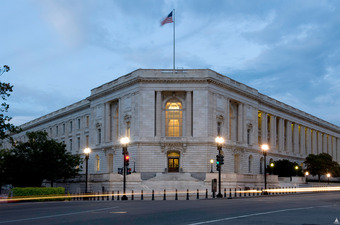
Russell Senate Office Building
The Russell Senate Office Building houses several Congressional staff members, including those on the United States Senate Committees on Armed Services, Rules and Administration, Veterans’ Affairs, and others.
The first House Committee was appointed on April 2, 1789 to prepare and report such standing rules and orders of proceeding as well as the duties of a Sergeant-at-Arms to enforce those rules. Other committees were created as needed, on a temporary basis, to review specific issues for the full House. The House relied primarily on the Committee of the Whole to handle the bulk of legislative issues. The Committee on Ways and Means followed on July 24, 1789 during a debate on the creation of the Treasury Department over concerns of giving the new department too much authority over revenue proposals. The House felt it would be better equipped if it established a committee to handle the matter. This first Committee on Ways and Means had 11 members and existed for just two months. It later became a standing committee in 1801, a position it still holds today.

Ways and Means Committee Logo
The Ways and Means Committee has been an important committee in the U.S. since 1789
11.2.6: The Staff System
Congressional staff are employees of the United States Congress or individual members of Congress.
Learning Objective
Differentiate between the roles of different congressional staff; in the Congressional Research Service, Congressional Budget Office, and Government Accountability Office
Key Points
- In the year 2000, there were approximately 11,692 personal staff, 2,492 committee staff, 274 leadership staff, 5,034 institutional staff, 3,500 GAO employees, 747 CRS employees, and 232 CBO employees.
- Every Representative hired 14 staff members, while the average Senator hired 34. In 2000, Representatives had a limit of 18 full-time and four part-time staffers, while Senators had no limit on staff.
- Majority and minority members hire their own staff except for two committees in each house: the Committee on Standards of Official Conduct and the Permanent Select Committee on Intelligence in the House, and the Select Committee on Ethics and Senate Select Committee on Intelligence in the Senate.
Key Terms
- Congressional Research Service
-
The Congressional Research Service (CRS), known as Congress’s think tank, is a public policy research arm of the United States Congress.
- Congressional Budget Office
-
The Congressional Budget Office (CBO) is a federal agency within the legislative branch of the United States government that provides economic data to Congress.
- Government Accountability Office
-
The Government Accountability Office (GAO) is the audit, evaluation, and investigative arm of the United States Congress.
- appropriation
-
Public funds set aside for a specific purpose.
Congressional staff are employees of the United States Congress or individual members of Congress. The various types of congressional staff are as follows: personal staff, who work for individual members of Congress; committee staff, who serve either the majority or minority on congressional committees; leadership staff, who work for the speaker, majority and minority leaders, and the majority and minority whips; institutional staff, who include the majority and minority party floor staff and non-partisan staff; and the support agency staff, who are the non-partisan employees of the Congressional Research Service (CRS), Congressional Budget Office (CBO), and Government Accountability Office (GAO).
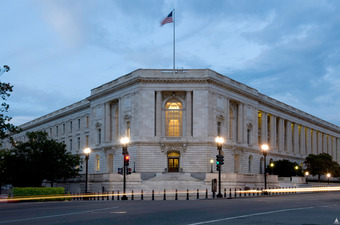
Russell Senate Office Building
The Russell Senate Office Building houses several Congressional staff members, including those on the United States Senate Committees on Armed Services, Rules and Administration, Veterans’ Affairs, and others.
In the year 2000, there were approximately 11,692 personal staff, 2,492 committee staff, 274 leadership staff, 5,034 institutional staff, 747 CRS employees, and 232 CBO employees, and 3,500 GAO employees. Every Representative hired 14 staff members, while the average Senator hired 34. Representatives had a limit of 18 full-time and four part-time staffers, while Senators had no limit on staff.
Each congressional committee has a staff of varying size. Appropriations for committee staff are made in annual legislative appropriations bills. Majority and minority members hire their own staff, with the exception of two committees in each house: the Committee on Standards of Official Conduct and the Permanent Select Committee on Intelligence in the House, and the Select Committee on Ethics and the Senate Select Committee on Intelligence in the Senate. These committees have a single staff.
In 2000, House committees had an average of 68 staff, and Senate committees an average of 46. Committee staff includes staff directors, committee counsel, committee investigators, press secretaries, chief clerks and office managers, schedulers, documents clerks, and assistants.
11.2.7: The Caucus
A caucus is a meeting of supporters or members of a political party or movement.
Learning Objective
Differentiate between two different types of political caucus
Key Points
- The term caucus is often used to discuss procedures implemented by states, including Iowa and Texas, to select presidential nominees.
- Depending on how the caucus is organized, the caucus system may require voters to publicly announce the candidates they support. Voters have the option to draft resolutions introduced at later divisional caucuses or conventions.
- A caucus can also be a sub-grouping of officials who convene to advocate, agitate, lobby or vote collectively on policy.
Key Term
- bicameral
-
Having, or pertaining to, two separate legislative chambers or houses.
A caucus is a meeting of supporters or members of a political party or movement. Members of a political party or subgroup may meet to coordinate actions, choose group policy or nominate candidates for various offices.The term caucus is often used to discuss procedures implemented by states, including Iowa and Texas, to select presidential nominees. . Since 1980, caucuses have become an important component of the nomination process.

Iowa Caucus
The Iowa Caucus is the first major electoral event of the nominating process for President of the United States.
Despite a Democratic Party rule that delegates are allocated proportionally rather than “winner takes all,” some caucus groups decide individually how to allocate their group’s delegates. Discussion of party rules is not necessarily part of the caucus experience, while few rules govern the actual process. In the “winner-take-all” scenario, a group’s delegate allocation may be reported as unanimous while ignoring minority votes. Depending on how the caucus is organized, the caucus system may require voters to publicly announce the candidates they support. Voters have the option to draft resolutions introduced by delegates at later divisional caucuses or conventions.
A caucus can also be a sub-grouping of officials with shared affinities or ethnicities. These officials convene to advocate, agitate, lobby or to vote collectively on policy. At the congressional and legislative levels, Democratic and Republican members organize themselves into a caucus.
There can also be smaller caucuses in a legislative body, including those that are multi-partisan or bicameral. One of the best-known is the Congressional Black Caucus, a group of African-American congressmen. Another prominent example is the Congressional Hispanic Caucus, whose members advance issues affecting Hispanics. In a different vein, the Congressional Internet Caucus is a bipartisan group promoting the growth and advancement of the Internet. Other congressional caucuses like the Out of Iraq Caucus strive to achieve political goals, generally organized around a single issue.
11.2.8: Congressional Districts
The quantity and boundaries of the 435 districts are determined after each census gauges the population shifts in each state.
Learning Objective
Describe what determines the quantity and boundaries of congressional districts
Key Points
- The boundaries of districts often shift with each redistricting. Over time, the region and demographics represented in a district can change substantially.
- As of the 2000 census, the average population per district is 646,946 people. California, with 53 districts, has the most. States with only one district include Alaska, Delaware, Montana, North Dakota, South Dakota, Vermont, and Wyoming.
- Alaska is the district with the greatest area and New York’s 15th district has the smallest area. Montana’s district has the largest number of people (905,316) and Wyoming has the fewest number of people (495,304). Delaware is the oldest district.
Key Terms
- apportion
-
To divide and distribute portions of a whole.
- apportionment
-
The act of apportioning or the state of being apportioned
Congressional Districts
The quantity (apportionment) and boundaries (redistricting) of districts are determined after each census, although in some cases states have changed the boundaries more than once per census. The census is used to gauge each state’s population and thus, proportional need for representation. Due to the shifts in population a state may gain or lose congressional districts. For example, since the 2000 census, Nebraska has had three districts, but it used to have as many as six. Texas currently has 32 districts, but will be adding 4 due to reapportionment as a result of the 2010 census. Other states will lose districts since the number of congressional seats has been set at 435 by statute.
The boundaries of districts often shift with each redistricting. Over time, the region and demographics represented in a district can change substantially. Furthermore, districts sometimes retain the same boundaries while changing their district numbers.

U.S. District Map
This map shows the U.S. Congress House Districts for the 110th-112th Congresses.
As of the 2000 census, the average population per district is 646,946 people. California had the most, at 53 districts. States with only one district include Alaska, Delaware, Montana, North Dakota, South Dakota, Vermont, and Wyoming. Alaska, Delaware, and Wyoming are the only states that have never had more than one district. Alaska is the district with the greatest area and New York’s 15th district has the smallest area. Montana’s district has the largest number of people (905,316) and Wyoming has the fewest number of people (495,304). Delaware is the oldest district; It has had the same geographical borders since 1789.
11.3: The Legislative Function of Congress
11.3.1: How a Bill Becomes Law
A bill is introduced by a member of the legislature, read through, debated, and then passed to become a law.
Learning Objective
Explain the process by which a bill becomes a law through the legislative and executive branches of government
Key Points
- In the US system, where the executive is formally separated from the legislature, all bills must originate from the legislature.
- In the U.S. Congress, a system of committees considers law relating to each policy area jurisdictions. The committee system is a way to provide for specialization, or a division of the legislative labor.
- At the second reading the general merits of the bill are considered. The committee reports to the legislature and further amendments are proposed. A third reading debate occurs and the bill is submitted.
- Bills passed by the legislature usually require the approval of the executive to become law. The legislature often has the power to override the veto of the executive by means of a supermajority. Any branch at anytime may decline the proposed bill.
Key Term
- fiat
-
An authoritative command or order to do something; an effectual decree.
How a Bill Becomes Law
A bill is introduced by a member of the legislature. While mechanisms exist to allow other members of the legislature to introduce bills, these are subject to strict timetables and usually fail unless a consensus is reached. In the U.S. system, where the executive is formally separated from the legislature, all bills must originate from the legislature.
Bills can be introduced through leave and government motion. Leave is when a motion is brought before the house asking that leave be given to bring in a bill. The legislator has 10 minutes to propose a bill, which can then be considered by the House on a day appointed for the purpose. While this rule still exists in the rules of procedure of the U.S. Congress, it is seldom used. A government motion occurs in jurisdictions where the executive can control legislative business a bill may be brought in by executive fiat.
A system of committees considers law relating to each policy area jurisdictions in the U.S. Congress. Thousands of bills are introduced in every session of Congress and no single member can possibly be adequately informed on all the issues that arise. The committee system is a way to provide for specialization, or a division of the legislative labor. Committees usually have the final say on pieces of legislation and only very rarely are deprived of control of a bill; although this kind of action is allowed in the rules of each chamber.
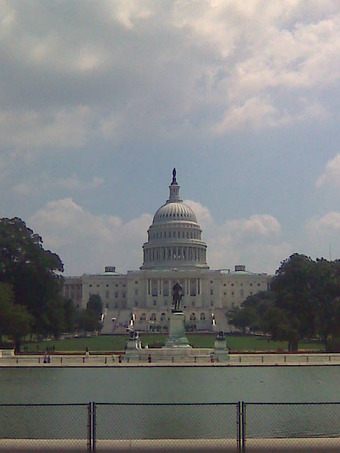
Capitol Hill
The U.S. has a bicameral legislature in Congress, consisting of the House of Representatives and the Senate
House and Senate Committees
A congressional committee is a legislative sub-organization in the United States Congress that handles a specific duty. Committee membership enables members to develop specialized knowledge of the matters under their jurisdiction. Congress divides its legislative, oversight, and internal administrative tasks among approximately 200 committees and subcommittees.
There are three main types of committees—standing, select or special, and joint. In the House of Representatives, there are 21 permanent committees, and 20 in the United States Senate. Four joint committees operate with members from both houses on matters of mutual jurisdiction and oversight. Committees in the House of Representatives generally have more members, due its larger size, as compared to the smaller 100-member Senate. Senate rules fix the maximum size for many of its committees, while the House determines the size and makeup of each committee every new Congress.
Bills are generally considered through a number of readings. This refers to the historic practice of the clerical officers of the legislature reading the contents of a bill to the legislature. While the bill is no longer read, the motions on the bill still refer to this practice.
At the second reading the general merits of the bill are considered. After which, the bill is referred to a committee, considering the bill line by line proposing amendments. The committee reports to the legislature, at which stage further amendments are proposed. Finally a third reading debate at which the bill as amended is considered in its entirety. The process is repeated in the other house, before the Bill is submitted to the executive for approval.
Bills passed by the legislature usually require the approval of the executive to become law. The need to receive approval can be used as a political tool by the executive and its refusal is known as a veto. The legislature often has the power to override the veto of the executive by means of a supermajority. Any branch at anytime may decline the proposed bill.
11.3.2: Committee Deliberation
Deliberation is a process of thoughtfully weighing options, usually prior to voting, emphasizing the use of logic and reason.
Learning Objective
Identify the significance of committee deliberation in the legislative process
Key Points
- In deliberative democracy the aim is for both elected officials and the general public to use deliberation rather than power-struggle as the basis for their vote and is a form of democracy in which deliberation is central to decision making.
- Deliberative democracy differs from traditional democratic theory in that authentic deliberation, not mere voting, is the primary source of legitimacy for the lawmaking processes.
- A deliberative assembly is an organization comprising members who use parliamentary procedure to make decisions. A committee is a small deliberative assembly subordinate to a larger deliberative assembly.
Key Term
- subordinate
-
Placed in a lower class, rank, or position.
Deliberation and Democracy
Deliberation is a process of thoughtfully weighing options, usually prior to voting. Deliberation emphasizes the use of logic and reason as opposed to power-struggle, creativity, or dialogue. Group decisions are generally made after deliberation through a vote of those involved.
In deliberative democracy the aim is for both elected officials and the general public to use deliberation rather than power-struggle as the basis for their vote. Deliberative democracy is a form of democracy in which deliberation is central to decision making. It adopts elements of both consensus decision-making and majority rule. Deliberative democracy differs from traditional democratic theory in that authentic deliberation, not mere voting, is the primary source of legitimacy for the lawmaking processes.
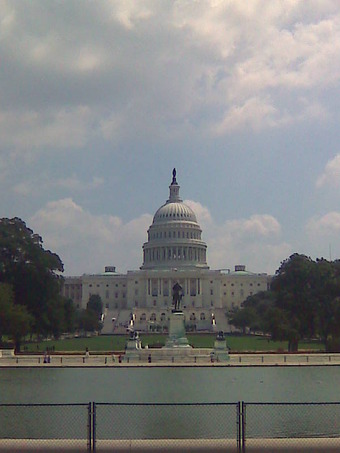
Capitol Hill
Capitol Hill, where bills become laws.
Debate in the U.S. Congress
Each bill goes through several stages in each house including consideration by a committee and advice from the Government Accountability Office. Most legislation is considered by standing committees which have jurisdiction over a particular subject such as Agriculture or Appropriations. The House has twenty standing committees; the Senate has sixteen. Standing committees meet at least once each month. Almost all standing committee meetings for transacting business must be open to the public unless the committee votes, publicly, to close the meeting. A committee might call for public hearings on important bills. Each committee is led by a chair who belongs to the majority party and a ranking member of the minority party. Witnesses and experts can present their case for or against a bill. Then, a bill may go to what’s called a mark-up session where committee members debate the bill’s merits and may offer amendments or revisions. Committees may also amend the bill, but the full house holds the power to accept or reject committee amendments. After debate, the committee votes whether it wishes to report the measure to the full house. If a bill is tabled then it is rejected. If amendments are extensive, sometimes a new bill with amendments built in will be submitted as a so-called clean bill with a new number. Both houses have procedures under which committees can be bypassed or overruled but they are rarely used. Generally, members who have been in Congress longer have greater seniority and therefore greater power.
A bill which reaches the floor of the full house can be simple or complex and begins with an enacting formula such as “Be it enacted by the Senate and House of Representatives of the United States of America in Congress assembled. ” Consideration of a bill requires, itself, a rule which is a simple resolution specifying the particulars of debate—time limits, possibility of further amendments, and such. Each side has equal time and members can yield to other members who wish to speak. Sometimes opponents seek to recommit a bill which means to change part of it. Generally, discussion requires a quorum, usually half of the total number of representatives, before discussion can begin, although there are exceptions. The house may debate and amend the bill; the precise procedures used by the House and Senate differ. A final vote on the bill follows.
Once a bill is approved by one house, it is sent to the other which may pass, reject, or amend it. For the bill to become law, both houses must agree to identical versions of the bill. If the second house amends the bill, then the differences between the two versions must be reconciled in a conference committee, an ad hoc committee that includes both senators and representatives sometimes by using a reconciliation process to limit budget bills. Both Houses use a budget enforcement mechanism informally known as pay-as-you-go or paygo which discourages members from considering acts which increase budget deficits. If both houses agree to the version reported by the conference committee, the bill passes, otherwise it fails. In this respect, this is how bills “die” in committees.
The Constitution specifies that a majority of members known as a quorum be present before doing business in each house. However, the rules of each house assume that a quorum is present unless a quorum call demonstrates the contrary. Since representatives and senators who are present rarely demand quorum calls, debate often continues despite the lack of a majority.
11.3.3: Debate
Debate is contention in argument and a method of interactive representational argument, and often occurs in Congress.
Learning Objective
Discuss the role that debate plays in the United States Congress
Key Points
- Debate is a broader form of argument than deductive reasoning, which only examines whether a conclusion is a consequence of premises, and factual argument, which only examines what is or isn’t the case, or rhetoric, which is a technique of persuasion.
- Though logical consistency, factual accuracy and emotional appeal to the audience are important elements of the art of persuasion, in debating, one side often prevails over the other side by presenting a superior context and framework of the issue, which is far more subtle and strategic.
- Debating is commonly carried out in many assemblies of various types to discuss matters and to make resolutions about action to be taken, often by a vote.
Key Terms
- filibuster
-
A delaying tactic, especially the use of long, often irrelevant speeches given in order to delay progress or the making of a decision, especially on the floor of the US Senate.
- rhetoric
-
The art of using language, especially public speaking, as a means to persuade.
Debate is contention in argument, dispute, controversy, and discussion. It is a method of interactive and representational argument. Debate is a broader form of argument than deductive reasoning, which only examines whether a conclusion is a consequence of premises, and factual argument, which only examines what is or isn’t the case, or rhetoric, which is a technique of persuasion. Debates are often organized for purely competitive purposes.
The use of debate in Congress often occurs when a new bill is introduced, especially if that bill is controversial. Senators may debate a bill. In the Senate, Senators sometimes use this rule to filibuster a bill—that is, continue debating a bill endlessly so that it cannot be voted on. The only way to end a filibuster is for three-fifths of all Senators to vote for a cloture resolution, which ends all debate and brings the bill up for voting. Use of the filibuster tends to be controversial. Whichever party is in the majority tends to call its use “obstructionism,” while the other side sees it as an important check on the majority.
Because of its size, the House relies heavily upon fixed rules and strict timetables for debate. When bills are debated on the floor of the House, each party’s leader is allocated a fixed amount of time to present their argument for or against the bill, and they can delegate this time to members of their party as they see fit. During House debates, it is common for representatives to “yield their time” to one another. Times for debate and other procedures are set by the House Rules Committee, which is generally considered to be one of the most powerful committees in Congress.
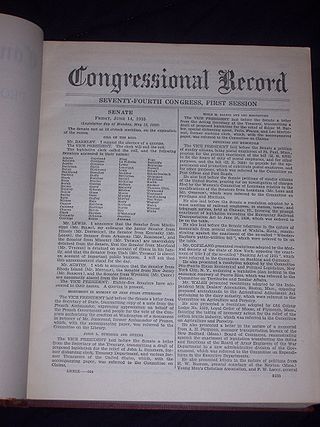
Congressional Records
The Congressional Records contain sections of verbatum congressional debates.
11.3.4: Conference Committee
A conference committee is a committee of Congress appointed by the House and Senate to resolve disagreements on a particular bill.
Learning Objective
Explain the function of the conference committee in the legislative process
Key Points
- The conference committee is usually composed of the senior Members of the standing committees of each House that originally considered the legislation.
- Conference committees exist to draft a compromise bill that both houses can accept. Both houses of Congress must eventually pass the identical legislation for the bill to become law.
- Each house determines the number of conferees from its house. The number of conferees need not be equal from each side. In order to conclude its business, a majority of both House and Senate delegations to the conference must indicate their approval by signing the conference report.
- The authority to appoint conferees lies in the entire House, and the entire Senate can appoint conferees by adopting a debatable motion to do so, but leadership has increasingly exercised authority in the appointment of conferees.
- The conference committee produces a conference report melding the work of the House and Senate into a final version of the bill and the conference report also includes a joint explanatory statement of the conference committee.
Key Terms
- standing committee
-
a committee established by an official and providing for its scope and power
- chair
-
Chairperson.
- joint committee
-
a Congressional committee consisting of Members of both Houses and having jurisdiction over matters of joint interest
- conference committee
-
a joint committee of a bicameral legislature, which is appointed by, and consists of, members of both chambers to resolve disagreements on a particular bill
A conference committee is a committee of Congress appointed by the House of Representatives and Senate to resolve disagreements on a particular bill. The conference committee is usually composed of the senior members of the standing committees of each house that originally considered the legislation.
Conference committees operate after the House and the Senate have passed different versions of a bill. Conference committees exist to draft a compromise bill that both houses can accept. Both houses of Congress must eventually pass the identical legislation for the bill to become law. The two houses can reach that identical product through the process of amendments between Houses, where the House passes the Senate bill with a House amendment, or vice versa. Thus most major bills become law through using a conference committee.
After one house passes a bill, the second house will often pass the same bill, with an amendment representing the second house’s work product. The second house will then send a message to the first house, asking the first house to concur with the second house’s amendment. If the first house does not like the second house’s amendment, then the first house can disagree with the amendment of the second house, request a conference, appoint conferees, and send a message to that effect to the second house. The second house then insists on its amendment, agrees to a conference, and appoints conferees.
Each house determines the number of conferees from its house. The number of conferees need not be equal from each side. In order to conclude its business, a majority of both House and Senate delegations to the conference must indicate their approval by signing the conference report.
The authority to appoint conferees lies in the entire House, and the entire Senate can appoint conferees by adopting a debatable motion to do so. But leadership have increasingly exercised authority in the appointment of conferees. The House and Senate may instruct conferees, but these instructions are not binding on conferees.
Conference committees can be extremely contentious, particularly if the houses are controlled by different parties . House rules require that one conference meeting be open to the public, unless the house, in open session, votes that a meeting will be closed to the public. But apart from this one open meeting, conference committees usually meet in private and are dominated by the Chairs of the House and Senate Committees.
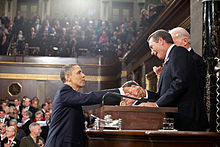
John Boehner
Speaker of the House John Boehner (R), seen here with President Barack Obama during the 2011 State of the Union, called for a conference committee to discuss new tax policies that were introduced to the house in 2011. Critics say he used the conference committees to stall the passing of any tax compromises.
House and Senate rules forbid Conferees from inserting into their report matter not committed to them by either house, but conference committees sometimes do introduce new matter. In such a case, the rules of each house provide that a Member may object through a point of order, although each house has procedures under which it can vote to waive the point of order. The house provides a procedure by which the offending provision may be stricken from the bill. Formerly, the Senate required a Senator to object to the whole bill as reported by the conference committee. If the objection was well founded, the Presiding Officer ruled and a Senator could appeal the ruling of the Chair. If the appeal was sustained by a majority of the Senate, it had precedential effect, eroding the rule on the scope of conference committees.
The conference committee produces a conference report melding the work of the House and Senate into a final version of the bill. A conference report proposes legislative language as an amendment to the bill and also includes a joint explanatory statement of the conference committee. This explanatory statement provides one of the best sources of legislative history on the bill.
Once a bill has been passed by a conference committee, it goes directly to the floor of both houses for a vote, and is not open to further amendment. In the first house to consider the conference, a Member may move to recommit the bill to the conference committee. But once the first house has passed the conference report, the conference committee is dissolved and the second house to act can no longer recommit the bill to conference.
11.3.5: Presidential Action
The Ineligibility Clause prevents the President from being a member of Congress and cannot directly introduce legislative proposals.
Learning Objective
Identify the role of the President in drafting and passing bills into federal law
Key Points
- The President can take an indirect role in shaping legislation, especially if the president’s political party has a majority in Congress.
- According to Article II, Section 3, Clause 2 of the Constitution, the president may convene either or both houses of Congress.
- The President cannot directly introduce legislative proposals for consideration in Congress.
Key Term
- adjourn
-
Temporarily ending an event with intentions to complete it at another time or place.
The President of the United States has limited legislative powers. The Constitution’s Ineligibility Clause prevents the President from simultaneously being a member of Congress. Therefore, the president cannot directly introduce legislative proposals for consideration in Congress. However, the president can take an indirect role in shaping legislation, especially if the president’s political party has a majority in one or both houses of Congress.
For example, the president or other officials of the executive branch may draft legislation and then ask senators or representatives to introduce these drafts into Congress. The president can further influence the legislative branch through constitutionally mandated, periodic reports to Congress. These reports may be either written or oral, but today are given as the State of the Union address, which often outlines the president’s legislative proposals for the coming year.
In the 20th century critics began charging that too many legislative and budgetary powers have slid into the hands of presidents that should belong to Congress. As the head of the executive branch, presidents control a vast array of agencies that can issue regulations with little oversight from Congress. One critic charged that presidents could appoint a virtual army of ‘czars’ each wholly unaccountable to Congress yet tasked with spearheading major policy efforts for the White House. Presidents have been criticized for making singing statements when signing congressional legislation about how they understand a bill or plan to execute it. This practice has been criticized by the American Bar Association (ABA, ) as unconstitutional. Conservative commentator George Will wrote of an increasingly swollen executive branch and the eclipse of Congress.

American Bar Association
Union Trust Building, Washington D.C.Home to the American Bar Association’s Branch office
According to Article II, Section 3, Clause 2 of the Constitution, the president may convene either or both houses of Congress. If both houses cannot agree on a date of adjournment, the president may appoint a date for Congress to adjourn.
11.4: The Budgeting Function of Congress
11.4.1: The Budgeting Process
Each year, the President of the United States submits his budget request to Congress.
Learning Objective
Describe the key components of the budget process and the current fiscal position of the United States
Key Points
- The Budget of the United States Government often begins as the President’s proposal to the U.S. Congress which recommends funding levels for the next fiscal year, beginning October 1.
- Several government agencies provide budget data and analysis. These include the Government Accountability Office (GAO), Congressional Budget Office, the Office of Management and Budget (OMB) and the U.S. Treasury Department.
- Social Security, Medicare, and Medicaid expenditures are funded by more permanent Congressional appropriations and so are considered mandatory spending.
- During 2011, the U.S. spent more on its military budget than the next 13 countries combined.
- The annual budget deficit is the difference between actual cash collections and budgeted spending (a partial measure of total spending) during a given fiscal year, which runs from October 1 to September 30.
Key Terms
- Public Debt
-
The United States public debt is the money borrowed by the federal government of the United States through the issuing of securities by the Treasury and other federal government agencies.
- budget
-
The amount of money or resources earmarked for a particular institution, activity, or time-frame.
Example
- The military budget of the United States during FY 2011 was approximately $740 billion in expenses for the Department of Defense (DoD), $141 billion for veteran expenses, and $48 billion in expenses for the Department of Homeland Security, for a total of $929 billion.
Introduction
The Budget of the United States Government often begins as the President’s proposal to the U.S. Congress which recommends funding levels for the next fiscal year, beginning October 1. However, Congress is the body required by law to pass a budget annually and to submit the budget passed by both houses to the President for signature. Congressional decisions are governed by rules and legislation regarding the federal budget process. Budget committees set spending limits for the House and Senate committees and for Appropriations subcommittees, which then approve individual appropriations bills to allocate funding to various federal programs.
Several government agencies provide budget data and analysis. These include the Government Accountability Office (GAO), Congressional Budget Office, the Office of Management and Budget (OMB) and the U.S. Treasury Department. These agencies have reported that the federal government is facing a series of important financing challenges. In the short-run, tax revenues have declined significantly due to a severe recession and tax policy choices, while expenditures have expanded for wars, unemployment insurance and other safety net spending. In the long-run, expenditures related to healthcare programs such as Medicare and Medicaid are projected to grow faster than the economy overall as the population matures.
Major Expenditure Categories
During FY 2012, the federal government spent $3.54 trillion on a budget or cash basis, down $60 billion or 1.7% vs. FY 2011 spending of $3.60 trillion. Major categories of FY 2012 spending included: Medicare & Medicaid ($802B or 23% of spending), Social Security ($768B or 22%), Defense Department ($670B or 19%), non-defense discretionary ($615B or 17%), other mandatory ($461B or 13%) and interest ($223B or 6%). Social Security spending increased versus 2011 while Defense, Medicare and Medicaid spending fell.
Social Security, Medicare, and Medicaid expenditures are funded by more permanent Congressional appropriations and so are considered mandatory spending. Social Security and Medicare are sometimes called “entitlements,” because people meeting relevant eligibility requirements are legally entitled to benefits, although most pay taxes into these programs throughout their working lives. Some programs, such as Food Stamps, are appropriated entitlements. Some mandatory spending, such as Congressional salaries, is not part of any entitlement program. Mandatory spending accounted for 57.4% of total federal outlays in FY2012, with net interest payments accounting for an additional 6.3%. In 2000, these were 53.2% and 12.5%, respectively.
Other Expenditures
The military budget of the United States during FY 2011 was approximately $740 billion in expenses for the Department of Defense (DoD), $141 billion for veteran expenses, and $48 billion in expenses for the Department of Homeland Security, for a total of $929 billion. Much of the costs for the wars in Iraq and Afghanistan have not been funded through regular appropriations bills, but through emergency supplemental appropriations bills. As such, most of these expenses were not included in the budget deficit calculation prior to FY2010. Some budget experts argue that emergency supplemental appropriations bills do not receive the same level of legislative care as regular appropriations bills. During 2011, the U.S. spent more on its military budget than the next 13 countries combined.
Non-defense discretionary spending is used to fund the executive departments (e.g., the Department of Education) and independent agencies (e.g., the Environmental Protection Agency), although these do receive a smaller amount of mandatory funding as well. Discretionary budget authority is established annually by Congress, as opposed to mandatory spending that is required by laws that span multiple years, such as Social Security or Medicare.
The annual budget deficit is the difference between actual cash collections and budgeted spending (a partial measure of total spending) during a given fiscal year, which runs from October 1 to September 30. Since 1970, the U.S. federal government has run deficits for all but four years (1998–2001) contributing to a total debt of $16.1 trillion as of September 2012.
Public Debt
The United States public debt is the money borrowed by the federal government of the United States through the issuing of securities by the Treasury and other federal government agencies. US public debt consists of two components: Debt held by the public includes Treasury securities held by investors outside the federal government, including that held by individuals, corporations, the Federal Reserve System and foreign, state and local governments. Individuals, corporations, the Federal Reserve System and foreign, state and local governments.
Debt held by government accounts or intragovernmental debt includes non-marketable Treasury securities held in accounts administered by the federal government that are owed to program beneficiaries, such as the Social Security Trust Fund. Debt held by government accounts represents the cumulative surpluses, including interest earnings, of these accounts that have been invested in Treasury securities.
11.4.2: Preparing the Budget
The Office of Management and Budget (OMB) performs key tasks in preparing the presidential budget request that is submitted to Congress.
Learning Objective
Summarize the key role played by the Office of Management and Budget in shaping the President’s budget request
Key Points
- The OMB’s primary mission is to assist the president in overseeing the preparation of the federal budget and to supervise the administration of that budget in executive branch agencies.
- Tasks undertaken by the OMB, in order to help the president generate a budget, include evaluating the effectiveness of agency programs, policies, and procedures, and assessing competing funding demands among agencies.
- The fact that the organizational structure of the OMB, and its staff, remain unchanged regardless of which party occupies the White House, facilitates the budget process.
Key Terms
- Office of Management and Budget
-
The largest office within the Executive Office of the President, the OMB is in charge of overseeing the preparation of the federal budget and the administering of that budget within the federal branch.
- legislation
-
Law which has been enacted by legislature or other governing body
- budget
-
The amount of money or resources earmarked for a particular institution, activity, or time-frame.
Introduction
A great deal of preparation goes into the president’s budget request submission, which is entitled, Budget of the U.S. Government. Before it is submitted, the president spends months working with the Office of Management and Budget (OMB) to formulate this budget request . The Office of Management and Budget is the largest office within the Executive Office of the President. The OMB’s primary mission is to assist the president as he or she supervises the preparation of the federal budget. It is also responsible, later, for administering that budget to executive branch agencies.

U.S. Office of Management and Budget Seal
The Office of Management and Budget plays a key role in preparing the president’s budget request to Congress.
OMB’s Responsibilities
In order to aid the president in generating a budget submission, the OMB evaluates the effectiveness of various agency programs, policies, and procedures. The OMB also assesses competing funding demands among agencies in order to decide upon funding priorities. In preparation for submitting a final presidential budget request to Congress, the OMB also ensures that reports from individual agencies, along with any rules, testimony, and proposed legislation, are consistent with the president’s budget request and administration policies.
OMB’s Structure
The structure of the OMB facilitates the preparation of the budget and the later submission of that budget to Congress. OMB staff provide the Executive Office of the President with vital continuity, because they are among the several hundred career professionals that remain in their positions regardless of which party occupies the White House. The largest offices of the OMB are the four Resource Management Offices. Staff members from these offices are assigned to monitor federal agencies or topical areas, like issues associated with U.S. Navy warships. They perform in-depth program evaluations and review federal agency budget requests to decide which resource requests will be sent to Congress under the president’s budget. In addition to these departments, staff members from the Office of General Counsel, the Office of Legislative Affairs, the Budget Review Division, and the Legislative Reference Division provide important support for the general operations of the OMB.
11.4.3: The Election Year Budget
Budget proposals during election years are usually politicized to gain votes and increase constituency support.
Learning Objective
Summarize the various conflicts that can plague the federal budget
Key Points
- The Budget of the United States Government often begins as the President’s proposal to the U.S. Congress which recommends funding levels for the next fiscal year, beginning October 1.
- The annual budget deficit is the difference between actual cash collections and budgeted spending (a partial measure of total spending) during a given fiscal year, which runs from October 1 to September 30.
- The debate between the executive and the House has carried on into the presidential election, in which incumbent Democrat President Obama’s spending policies are compared against those of Republican vice-presidential candidate and current House Budget Committee chairman, Paul Ryan.
- While both executive and House budget plans focus on deficit reduction, they differ in their changes to taxation, entitlement programs, defense spending, and research funding.
Key Terms
- budget
-
The amount of money or resources earmarked for a particular institution, activity, or time-frame.
- budget deficit
-
the difference between government revenues and spending, in which the government is spending more than it’s earning
- fiscal
-
Related to the treasury of a country, company, region, or city, particularly to government spending and revenue.
- deficit
-
A situation wherein, or amount whereby, spending exceeds government revenue.
Example
- Since 1970, the U.S. federal government has run deficits for all but four years (1998–2001) contributing to a total debt of $16.1 trillion as of September 2012
Introduction
The Budget of the United States Government often begins as the President’s proposal to the U.S. Congress which recommends funding levels for the next fiscal year, beginning October 1. However, Congress is the body required by law to pass a budget annually and to submit the budget passed by both houses to the President for signature. Congressional decisions are governed by rules and legislation regarding the federal budget process. Budget committees set spending limits for the House and Senate committees and for Appropriations subcommittees, which then approve individual appropriations bills to allocate funding to various federal programs.
Understanding Deficits and Debt
The annual budget deficit is the difference between actual cash collections and budgeted spending (a partial measure of total spending) during a given fiscal year, which runs from October 1 to September 30. Since 1970, the U.S. federal government has run deficits for all but four years (1998–2001) contributing to a total debt of $16.1 trillion as of September 2012 .
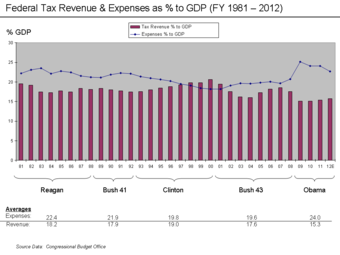
Revenue and Expense to GDP Chart 1993 – 2008
Tax and Spend percent GDP in United States 1981-2012,
Many of the debates surrounding the United States federal budget center around competing macroeconomic schools of thought. In general, Democrats favor the principles of Keynesian economics to encourage economic growth via a mixed economy of both private and public enterprise, a welfare state, and strong regulatory oversight. Conversely, Republicans generally support applying the principles of either laissez-faire or supply-side economics to grow the economy via small government, low taxes, limited regulation, and free enterprise.
Election-Year Budgets
The 1996 United States federal budget was the United States federal budget to fund government operations for the fiscal year 1996, which was October 1995 – September 1996. This budget was the first to be submitted after the Republican Revolution in the 1994 midterm elections. Disagreements between Democratic President Bill Clinton and Republicans led by Speaker of the House Newt Gingrich led to the United States federal government shutdown of 1995 and 1996.

U.S. President Bill Clinton
Official White House photo of President Bill Clinton, President of the United States.
The failure of Congress and the President to enact the remaining appropriations legislation led to government shutdowns during November 13–19, 1995 and December 15, 1995 through January 6, 1996. The shutdowns were triggered by the expiration of continuing resolutions. The first shutdown caused the furlough of about 800,000 federal employees, while the second affected 284,000 due to additional appropriations bills enacted in the interim.
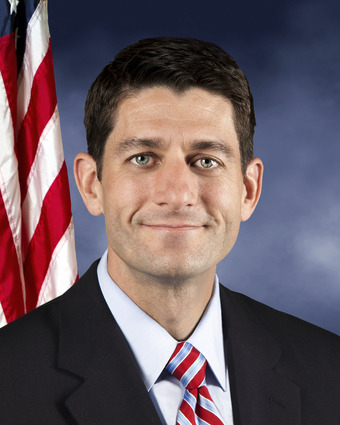
Paul Ryan
Rep. Paul Ryan is former head of the House Budget Committee, but now serves as the Speaker of the House.
The Obama Administration’s Budget Plans
The Obama administration’s 2012 budget request focused on reducing annual deficits to more sustainable levels by making certain cuts in spending while continuing to support areas that would promote long-term economic growth, such as education and clean energy. The plan did not contain proposals to rein in spending on entitlement programs expected to increase the deficit in future years, like Medicare, Medicaid, and Social Security. The 2012 budget plan was a shift from the Obama administration’s previous strategy of using increased government spending to stimulate the economy. Instead, the budget request was projected to reduce government deficits by 1.1 trillion dollars over the next ten years. Republicans have criticized the president’s plan for not going far enough to reduce future deficits.
The 2016 budget plan President Obama proposed requested 4 trillion in fiscal year 2016. His proposal called for 74 billion in additional discretionary spending above the sequestration caps set in place. The additional spending would be about evenly split between defense and non-defense discretionary programs.
This budget request is President Obama’s first on-time budget proposal since 2011. It included more than $1.15 trillion in discretionary spending, an increase of about 2 percent relative to 2015 enacted levels.
The president proposed $60 billion over 10 years for a new initiative that would allow students to attend community college for up to two years tuition free and would again provide expanded Head Start and universal pre-kindergarten.
The budget also includes $478 billion in additional infrastructure spending over the next six years, which would pay for surface transportation improvements such as roads and bridges. The president proposes to pay for this through various tax reforms.
11.4.4: Budget Resolutions
The budget resolution serves as a blueprint for the actual appropriations process and provides Congress with some control over the process.
Learning Objective
Summarize the aims and shape of Congress’s annual budget resolution
Key Points
- The budget resolution establishes budget totals, allocations, entitlements, and sometimes includes reconciliation instructions to certain House or Senate committees. Federal spending is apportioned among 20 functional categories such as national defense, agriculture, and transportation.
- The budget resolution sets spending ceilings for the Congressional committees with jurisdiction over spending.
- The budget resolution is created in response to the president’s budget request according to the Congressional Budget and Impoundment Control Act of 1974.
- No penalty exists if the budget resolution is not completed by April 15th or if it is not completed at all.
Key Terms
- appropriations
-
In law and government, appropriation (from Latin appropriare, “to make one’s own,” later “to set aside”) is the act of setting apart something for its application to a particular usage to the exclusion of all other uses. It typically refers to the legislative designation of money for particular uses in the context of a budget or spending bill.
- fiscal
-
Related to the treasury of a country, company, region, or city, particularly to government spending and revenue.
- budget resolution
-
In the United States Congress, a budget resolution is a legislation in the form of a concurrent resolution setting forth the congressional budget. The budget resolution establishes various budget totals, allocations, and entitlements. It may include reconciliation instructions to designated House or Senate committees.
Congress must create an annual budget resolution in response to the President’s budget request according to the Congressional Budget and Impoundment Control Act of 1974 (also known as the Congressional Budget Act) . The budget resolution must cover the time span of a minimum of five fiscal years, which includes the upcoming fiscal year plus the four following fiscal years. The budget resolution establishes budget totals, allocations, entitlements, and sometimes includes reconciliation instructions to certain House or Senate committees. Federal spending is apportioned among 20 functional categories such as national defense, agriculture, and transportation.

Nixon Departing the White House after His Resignation
The Congressional Budget and Impoundment Control Act of 1974 (Congressional Budget Act), created during the Nixon administration, established the current budget resolution process.
The budget resolution also sets spending ceilings for the Congressional committees that have jurisdiction over spending. Even though the budget resolution covers at least five fiscal years, the House and Senate Committees on Appropriations receive allocations only for the upcoming fiscal year because appropriations measures are annual. After the appropriations committees receive their spending ceilings, they are responsible for dividing the amount among their respective subcommittees.
The budget resolution binds Congress, but it is not law since it is not sent to the President. It does not provide budget authority or change the level of revenues. Instead, the budget resolution serves as a blueprint for the actual appropriations process and provides Congress with some control over this process.
April 15th is the target date for congressional adoption of the budget resolution set by the Congressional Budget Act. However, Congress has frequently not met this target date since the fiscal year 1977. In some instances, Congress has not adopted a budget resolution. No penalty exists if the budget resolution is not completed by April 15th or if it is not completed at all. However, some enforceable spending ceilings cannot be established until the budget resolution is completed. The Congressional Budget Act also prohibits House and Senate floor consideration of appropriations measures for the upcoming fiscal year before the budget resolution is completed. However, the House can bypass this prohibition after May 15th and the Senate can bypass it by adopting a motion to waive the rule by majority vote.
11.4.5: Authorization and Appropriation
Authorizations and appropriations functions are separate in principle, but this separation is often imperfect in reality.
Learning Objective
Differentiate between authorization and appropriation
Key Points
- Authorization acts establish, continue, or modify agencies or programs.
- Appropriations acts provide new budget authority for programs, activities, and agencies that have been authorized by authorization committees.
- The separation of authorization and appropriation functions are enforced through House and Senate rules that divide committee jurisdiction between authorization and appropriations bills.
- The separation between authorization and appropriations measures is imperfect: prohibited language in appropriations bills can still be passed, some authorized programs receive no funding, and some unauthorized programs do receive funding.
Key Terms
- appropriation
-
Public funds set aside for a specific purpose.
- budget resolution
-
In the United States Congress, a budget resolution is a legislation in the form of a concurrent resolution setting forth the congressional budget. The budget resolution establishes various budget totals, allocations, and entitlements. It may include reconciliation instructions to designated House or Senate committees.
- authorization
-
Permission, possibly limited, to spend funds for a specific budgetary purpose.
The budget resolution adopted by Congress provides a blueprint for later authorization and appropriations measures. These measures are distinct from each other and perform different functions. Authorization acts establish, continue, or modify agencies or programs. For instance, an authorization act could establish or modify programs within a federal department. Authorization acts also authorize subsequent appropriations for specific agencies and programs, often setting spending ceilings for them. Meanwhile, appropriations acts provide new budget authority for programs, activities, and agencies that have been authorized by authorization committees.
The separation of authorization and appropriation functions are enforced through House and Senate rules that divide committee jurisdiction between authorization and appropriations bills . Points of order also prohibit certain provisions in appropriations measures. For instance, the House and Senate prohibit language in appropriations bills that provides appropriations not authorized by law, also known as unauthorized appropriations. An unauthorized appropriation is a new budget authority for agencies or programs either without authorization or where the budget authority exceeds the authorized ceiling. Language in an appropriations bill that provides legislation on the bill is additionally prohibited. In other words, language in appropriations measures cannot change existing law; legislation is solely the jurisdiction of legislative committees.

House Appropriations Committee Logo
Appropriations committees are distinct from authorization committees in principle, but the division is often imperfect in reality.
In reality, the separation between authorization and appropriation measures is imperfect. Authorization for many programs has long since expired, but these programs still receive appropriated amounts. Other authorized programs receive no appropriated funds at all. Meanwhile, the aforementioned language prohibitions in appropriations bills sometimes gets passed in the bills either because no one raised a point of order or the House and Senate waived the rules.
11.5: The Oversight Function of Congress
11.5.1: Investigation
Congressional oversight is the review, monitoring, and supervision of federal agencies, programs, activities, and policy implementation.
Learning Objective
Name several key enumerated powers that imply oversight authority
Key Points
- Congressional oversight refers to oversight by the United States Congress of the Executive Branch, including the numerous U.S. federal agencies. Congressional oversight refers to the review, monitoring, and supervision of federal agencies, programs, activities, and policy implementation.
- Congress’s oversight authority derives from its implied powers in the Constitution, public laws, and House and Senate rules. It is an integral part of the American system of checks and balances.
- Congress could not reasonably or responsibly exercise these powers without knowing what the executive was doing; how programs were being administered, by whom, and at what cost; and whether officials were obeying the law and complying with legislative intent.
- Oversight also is derived from the many and varied express powers of the Congress in the Constitution. Congress could not reasonably exercise its powers without knowing what the executive was doing; how programs were being administered, by whom, and at what cost.
Key Terms
- enumerated powers
-
The enumerated powers are a list of items found in Article I, Section 8 of the U.S. Constitution that set forth the authoritative capacity of Congress. In summary, Congress may exercise the powers that the Constitution grants it, subject to explicit restrictions in the Bill of Rights and other protections in the Constitution.
- implied powers
-
They are those powers authorized by a legal document (from the Constitution) which, while not stated, seem to be implied by powers expressly stated.
- congressional oversight
-
Congressional oversight refers to oversight by the United States Congress of the Executive Branch, including the numerous U.S. federal agencies.
Introduction
Congressional oversight refers to oversight by the United States Congress of the Executive Branch, including the numerous U.S. federal agencies. Congressional oversight refers to the review, monitoring, and supervision of federal agencies, programs, activities, and policy implementation. Congress exercises this power largely through its congressional committee system. However, oversight, which dates to the earliest days of the Republic, also occurs in a wide variety of congressional activities and contexts. These include authorization, appropriations, investigative, and legislative hearings by standing committees; specialized investigations by select committees; and reviews and studies by congressional support agencies and staff.
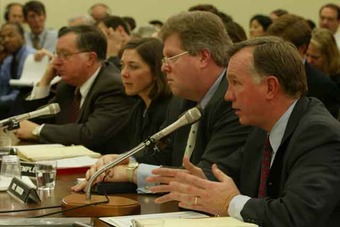
Arthur Andersen Witnesses
Arthur Andersen witnesses testify at the Subcommittee on Oversight and Investigations of the Committee on Energy and Commerce House of Representatives (107th Congress) hearing on January 24, 2002.
Congress’s oversight authority derives from its implied powers in the Constitution, public laws, and House and Senate rules. It is an integral part of the American system of checks and balances.
Report on the Organization of Congress
Oversight is an implied rather than an enumerated power under the U.S. Constitution. The government’s charter does not explicitly grant Congress the authority to conduct inquiries or investigations of the executive, have access to records or materials held by the executive, or to issue subpoenas for documents or testimony from the executive.
There was little discussion of the power to oversee, review, or investigate executive activity at the Constitutional Convention of 1787 or later in the Federalist Papers, which argued in favor of ratification of the Constitution. The lack of debate was based on the view that oversight and its attendant authority were inherent powers of representative assemblies, which enacted public law.
Oversight also is derived from the many and varied express powers of the Congress in the Constitution. It is implied in the legislature’s authority, among other powers and duties, that it can appropriate funds, enact laws, raise and support armies, provide for a Navy, declare war, and impeach and remove from office the president, vice president, and other civil officers. Congress could not reasonably or responsibly exercise these powers without knowing what the executive was doing; how programs were being administered, by whom, and at what cost; and whether officials were obeying the law and complying with legislative intent.
The U.S. Constitution
Although the Constitution grants no formal, express authority to oversee or investigate the executive or program administration, oversight is implied in Congress’s array of enumerated powers. The legislature is authorized to appropriate funds; raise and support armies; provide for and maintain a navy; declare war; provide for organizing and calling forth the national guard; regulate interstate and foreign commerce; establish post offices and post roads; advise and consent on treaties and presidential nominations (Senate); and impeach (House) and try (Senate) the President, Vice President, and civil officers for treason, bribery, or other high crimes and misdemeanors. Reinforcing these powers is Congress’s broad authority “to make all laws which shall be necessary and proper for carrying into execution the foregoing powers, and all other powers vested by this Constitution in the Government of the United States, or in any Department or Officer thereof.”
Activities and Training
Although the Constitution grants no formal, express authority to oversee or investigate the executive or program administration, oversight is implied in Congress’s array of enumerated powers. The legislature is authorized to appropriate funds; raise and support armies; provide for and maintain a navy; declare war; provide for organizing and calling forth the national guard; regulate interstate and foreign commerce; establish post offices and post roads; advise and consent on treaties and presidential nominations (Senate); and impeach (House) and try (Senate) the President, Vice President, and civil officers for treason, bribery, or other high crimes and misdemeanors. Reinforcing these powers is Congress’s broad authority “to make all laws which shall be necessary and proper for carrying into execution the foregoing powers, and all other powers vested by this Constitution in the Government of the United States, or in any Department or Officer thereof.”
11.5.2: Oversight
Oversight of various federal agencies is one of Congress’ enumerated powers.
Learning Objective
Describe the source and nature of Congress’s oversight function.
Key Points
- The authority to oversee the executive comes from the constitutional powers. Congress could not carry them out reasonably or responsibly without knowing what the executive is doing.
- Reinforcing these oversight powers is Congress’s broad authority to make all laws that shall be necessary and proper for carrying into execution the foregoing powers, all other powers vested by this Constitution in the government, or in any Department or Officer in the government.
- Besides these general powers, numerous statutes direct the executive to give information to or consult with Congress.
- Oversight occurs through a wide variety of congressional activities and avenues. Some of the most publicized are the comparatively rare investigations by select committees into major scandals or into executive branch operations gone awry.
Key Term
- subcommittee
-
A committee formed by an existing committee.
Example
- The Congressional Budget Act of 1974 (P.L. 93-344) allowed committees to conduct program evaluation themselves or contract out for it; strengthened GAO’s role in acquiring fiscal, budgetary, and program-related information; and upgraded GAO’s review capabilities.
Background
Although the Constitution grants no formal, express authority to oversee or investigate the executive or program administration, oversight is implied in Congress’s array of enumerated powers. The legislature is authorized to appropriate funds, raise and support armies, provide for and maintain a navy, declare war, provide for organizing and calling forth the national guard, regulate interstate and foreign commerce, establish post offices and post roads, advise and consent on treaties and presidential nominations (Senate), and impeach (House) and try (Senate) the President, Vice President, and civil officers for treason, bribery, or other high crimes and misdemeanors. Reinforcing these powers is Congress’s broad authority to make all laws that will be necessary to carry out execution the foregoing powers, all other powers vested by this Constitution in the government, or in any Department or Officer in the government.
The authority to oversee is derived from these constitutional powers. Congress could not carry them out reasonably or responsibly without knowing what the executive is doing; how programs are being administered, by whom, and at what cost; and whether officials are obeying the law and complying with legislative intent. The Supreme Court has legitimated Congress’s investigative power, subject to constitutional safeguards for civil liberties.
Statutes
The necessary and proper clause of the Constitution also allows Congress to enact laws that mandate oversight by its committees, grant relevant authority to itself and its support agencies, and impose specific obligations on the executive to report to or consult with Congress, and even seek its approval for specific actions. Broad oversight mandates exist for the legislature in several significant statutes.
Besides these general powers, numerous statutes direct the executive to furnish information to or consult with Congress. For example, the Government Performance and Results Act of 1993, requires agencies to consult with Congress on their strategic plans and report annually on performance plans, goals, and results. In fact, more than 2,000 reports are submitted each year to Congress by federal departments, agencies, commissions, bureaus, and offices. Inspectors general (IGs), for instance, report their findings about waste, fraud, and abuse. and their recommendations for corrective action, periodically to the agency head and Congress. The IGs are also instructed to immediately issue special reports concerning particularly serious problems to the agency head, who transmits them unaltered to Congress within seven days.
House and Senate Chamber rules also reinforce the oversight function. House and Senate rules, for instance, provide for “special oversight” or “comprehensive policy oversight,” respectively, for specified committees over matters that relate to their authorizing jurisdiction. In addition, House rules direct each standing committee to require its subcommittees to conduct oversight or to establish an oversight subcommittee for this purpose. House rules also call for each committee to submit an oversight agenda, listing its prospective oversight topics for the ensuing Congress, to the House Committee on Government Reform, which compiles and prints the agendas.
The House Government Reform Committee and the Senate Governmental Affairs Committee, which have oversight jurisdiction over virtually the entire federal government, are authorized to review and study the operation of government activities to determine their economy and efficiency and to submit recommendations based on GAO reports. In addition, House rules require that the findings and recommendations from the Government Reform Committee be considered by authorizing panels, if presented to them in a timely fashion.
Activities and Avenues
Oversight occurs through a wide variety of congressional activities and avenues. Some of the most publicized are the comparatively rare investigations by select committees into major scandals or into executive branch operations gone awry. Examples include temporary select committee inquiries into: China’s acquisition of U.S. nuclear weapons information, in 1999; the Iran-Contra affair, in 1987; intelligence agency abuses, in 1975-1976, and “Watergate,” in 1973-1974. The precedent for this kind of oversight goes back two centuries: in 1792, a special House committee investigated the defeat of an Army force by confederated Indian tribes.
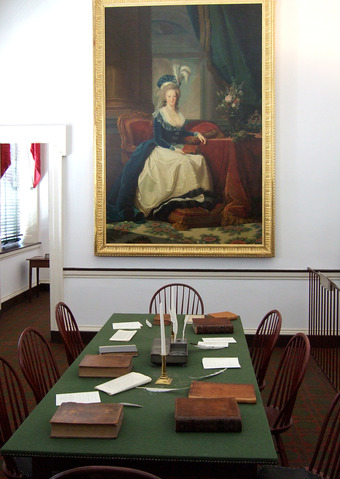
Congress Hall Committee Room Marie Antoinette
One of several committee rooms in Congress Hall, in Philadelphia, PA. The room is located on the second floor, on the west side of the building, adjacent to the Senate chamber. The view is looking toward the front of the building. The portrait of Marie Antoinette, by Élisabeth Vigée-Lebrun (1788), was presented as a gift from the French monarch following the American Revolution.
11.5.3: Advice and Consent
Advice and consent is a power of the Senate to be consulted on and approve treaties signed by the president.
Learning Objective
Describe the origins and development of the Senate’s “advise and consent” powers
Key Points
- The term “advice and consent” first appears in the United States Constitution in Article II, Section 2, Clause 2, referring to the Senate’s role in the signing and ratification of treaties.
- Typically, a congressional hearing is held to question the appointee. For a treaty, a two-thirds vote of the Senate is required anyway; thus, a filibuster could only delay passage.
- Several framers of the U.S. Constitution believed that the required role of the Senate is to advise the president after the nomination.
- Under the Twenty-fifth Amendment, appointments to the Office of Vice President are confirmed by a majority vote in both Houses of Congress, instead of just the Senate.
Key Term
- consent
-
To express willingness, to give permission.
Example
- The actual motion adopted by the Senate when exercising the power is “to advise and consent,” which shows how initial advice on nominations and treaties is not a formal power exercised by the Senate. For appointments, a majority of senators are needed to pass a motion “to advise and consent”, but unless the appointment has the support of three-fifths of senators, a filibuster blocking the passage of the motion is possible.
Background
In the United States, advice and consent is a power of the United States Senate to be consulted on and approve treaties signed and appointments made by the President of the United States to public positions, including Cabinet secretaries, federal judges, and ambassadors . This power is also held by several state Senates, which are consulted on and approve various appointments made by the state’s chief executive, such as some statewide officials, state departmental heads in the Governor’s cabinet, and state judges (in some states).
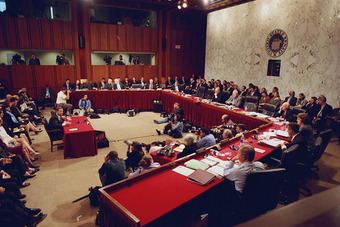
John Roberts Confirmation Hearings
Under the Constitution, the Senate have advice and consent on any nominations made by the President to the Supreme Court of the United States. Here, the Senate Judiciary Committee confirmation hearings of John Roberts to be Chief Justice of the Supreme Court of the United States, 2005.
Constitutional Provision
Article II, Section 2, paragraph two of the United States Constitution states: “The President shall have Power, by and with the Advice and Consent of the Senate, to make Treaties, provided two thirds of the Senators present concur; and he shall nominate, and by and with the Advice and Consent of the Senate, shall appoint Ambassadors, other public Ministers and Consuls, Judges of the supreme Court, and all other Officers of the United States, whose Appointments are not herein otherwise provided for, and which shall be established by Law: but the Congress may by Law vest the Appointment of such inferior Officers, as they think proper, in the President alone, in the Courts of Law, or in the Heads of Departments. “
The term “advice and consent” first appears in the United States Constitution in Article II, Section 2, Clause 2, referring to the Senate’s role in the signing and ratification of treaties. This term is then used again, to describe the Senate’s role in the appointment of public officials, immediately after describing the president’s duty to nominate officials .
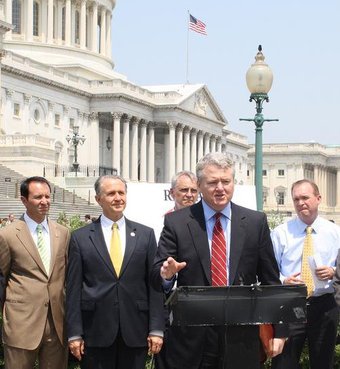
Advice and Consent
Senators also have the power of “advice and consent” over other authorities in the federal or state governments.
The founding fathers of the United States included the language as part of a delicate compromise concerning the balance of power in the federal government. Many delegates preferred to develop a strong executive control vested in the president, while others, worried about authoritarian control, preferred to strengthen the Congress. Requiring the president to gain the advice and consent of the Senate achieved both goals without hindering the business of government.
Under the Twenty-fifth Amendment, appointments to the Office of Vice President are confirmed by a majority vote in both Houses of Congress, instead of just the Senate.
Historical Development of Power
Several framers of the U.S. Constitution believed that the required role of the Senate is to advise the president after the nomination. Roger Sherman believed that advice before nomination could still be helpful. Likewise, President George Washington took the position that pre-nomination advice was allowable but not mandatory. The notion that pre-nomination advice is optional has developed into the unification of the advice portion of the power with the “consent” portion, although several presidents have consulted informally with senators over nominations and treaties.
Use today
The actual motion adopted by the Senate when exercising the power is “to advise and consent,” which shows how initial advice on nominations and treaties is not a formal power exercised by the Senate. For appointments, a majority of senators are needed to pass a motion “to advise and consent,” but unless the appointment has the support of three-fifths of senators, a filibuster blocking the passage of the motion is possible. Typically, a congressional hearing is held to question the appointee. For a treaty, a two-thirds vote of the Senate is required anyway; thus, a filibuster could only delay passage.
11.5.4: Impeachment and Removal from Office
Impeachment is an expressed power that allows for formal charges against a civil officer of government for crimes committed in office.
Learning Objective
Differentiate between the roles played by the House and Senate in impeachment proceedings.
Key Points
- Impeachment is analogous to indictment in regular court proceedings. Trial by the other house is analogous to the trial before judge and jury in regular courts. Typically, the lower house of the legislature will impeach the official and the upper house will conduct the trial.
- Impeachment proceedings may be commenced by a member of the House of Representatives on their own initiative, either by presenting a listing of the charges under oath or by asking for referral to the appropriate committee.
- The Senate enters judgment on its decision, whether that be to convict or acquit. A copy of the judgment is filed with the Secretary of State. Upon conviction, the official is automatically removed from office and may also be barred from holding future office.
Key Terms
- impeachment
-
the act of impeaching a public official, either elected or appointed, before a tribunal charged with determining the facts of the matter.
- indictment
-
An official formal accusation for a criminal offence or the process by which it is brought to a jury.
Example
- A United States federal judge named Walter Nixon was convicted of committing perjury before a grand jury. He refused to resign from office even after he had been incarcerated. Nixon was subsequently impeached by the United States House of Representatives. The matter was referred to the United States Senate for a vote on Nixon’s removal.
Background
Impeachment in the United States is an expressed power of the legislature that allows for formal charges against a civil government officer for crimes committed in office. The actual trial on those charges, and subsequent removal of an official on conviction on those charges, is separate from the act of impeachment itself.

The Senate as a Court of Impeachment for the Trial of Andrew Johnson
The Impeachment of Andrew Johnson
Impeachment is analogous to indictmentin regular court proceedings. Trial by the other house is analogous to the trial before judge and jury in regular courts. Typically, the lower house of the legislature will impeach the official and the upper house will conduct the trial.
At the federal level, Article II of the United States Constitution (Section 4), states that the President, Vice President, and all civil officers of the United States shall be removed from office on impeachment for, and in conviction of, treason, bribery, or other high crimes and misdemeanors. The House of Representatives has the sole power of impeaching, while the United States Senate has the sole power to try all impeachments. The removal of impeached officials is automatic upon conviction in the Senate.
The House of Representatives
Impeachment proceedings may be commenced by a member of the House of Representatives on their own initiative, either by presenting a listing of the charges under oath or by asking for referral to the appropriate committee. Non-members may trigger the impeachment process. For example, when the Judicial Conference of the United States suggests a federal judge be impeached, a charge of what actions constitute grounds for impeachment may come from a special prosecutor, the President, a state or territorial legislature, grand jury, or by petition.
The House debates the resolution and at the conclusion may consider the resolution as a whole or vote on each article of impeachment individually. A simple majority of those present and voting is required for each article or the resolution as a whole to pass. If the House votes to impeach, managers (typically referred to as House managers, with a lead House manager) are selected to present the case to the Senate. Recently, managers have been selected by resolution, while historically the House would occasionally elect the managers or pass a resolution allowing the appointment of managers at the discretion of the Speaker of the United States House of Representatives. These managers are roughly the equivalent of the prosecution/district attorney in a standard criminal trial.
Also, the House will adopt a resolution in order to notify the Senate of its action. After receiving the notice, the Senate will adopt an order notifying the House that it is ready to receive the managers. Then the House managers appear before the bar of the Senate and exhibit the articles of impeachment. After the reading of the charges, the managers return and make a verbal report to the House.
Senate
The proceedings unfold in the form of a trial, with each side having the right to call witnesses and perform cross-examinations. The House members, who are given the collective title of managers during the course of the trial, present the prosecution case. The impeached official has the right to mount a defense with his own attorneys as well. Senators must also take an oath or affirmation that they will perform their duties honestly and with due diligence (as opposed to the House of Lords in the Parliament of the United Kingdom, who vote upon their honor). After hearing the charges, the Senate usually deliberates in private. Conviction requires a two-thirds majority.
The Senate enters judgment on its decision, whether that is to convict or acquit. A copy of the judgment is filed with the Secretary of State. Upon conviction, the official is automatically removed from office and may also be barred from holding future office. The removed official is also liable to criminal prosecution. The President may not grant a pardon in the impeachment case, but may in any resulting criminal case.
11.5.5: Senate Confirmation
Senate confirmation is required for certain presidential appointments stated under the Constitution.
Learning Objective
Describe the significance of the Senate’s role in presidential appointments
Key Points
- Under the United States Constitution and law of the United States, certain federal positions appointed by the president of the United States require confirmation (advice and consent) of the United States Senate.
- United States Supreme Court Justices are appointed by the president and confirmed by the Senate. In theory, this procedure allows both the executive and legislative branches to have some power over the judiciary and thus check the judicial branch’s power.
- The principle of checks and balances allows branches of government to be isolated from each other so that no branch has total power over all functions of government…an attack on or abuse of power by individuals of a single branch will not lead to tyranny or the fall of the entire government.
Key Term
- checks and balances
-
A system for multiple parties wherein each has some control over the actions of each of the others.
Senate Confirmation
Background
Under the United States Constitution and law of the United States, certain federal positions appointed by the president of the United States require confirmation (advice and consent) of the United States Senate. These positions are referred to as Presidential Appointment with Senate confirmation (PAS).
PAS positions, as well as other types of federal government positions, are published in the United States Government Policy and Supporting Positions (Plum Book), which are released after each United States presidential election.
Senate Confirmation and Checks and Balances
United States Supreme Court Justices are appointed by the president and confirmed by the Senate. In theory, this procedure allows both the executive and legislative branches to have some power over the judiciary and thus check the judicial branch’s power. However, following confirmation by the Senate, all Supreme Court justices hold office for life unless they are impeached or they voluntarily retire. Because justices serve for life, their appointments can be politically controversial if they are perceived to have been appointed to implement or serve a more partisan agenda.
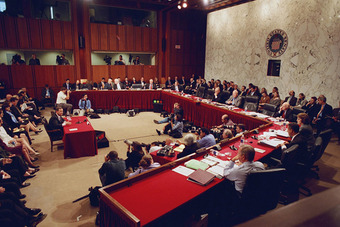
John Roberts Confirmation Hearings
Under the Constitution, the Senate have advice and consent on any nominations made by the President to the Supreme Court of the United States. Here, the Senate Judiciary Committee confirmation hearings of John Roberts to be Chief Justice of the Supreme Court of the United States, 2005.
The principle of checks and balances allows branches of government to be isolated from each other so that no branch has total power over all functions of government. As such, an attack on or abuse of power by individuals of a single branch will not lead to tyranny or the fall of the entire government. The judicial branch, however, holds the potential to nullify laws approved by the legislative branch, disregard the executive branch, and, (in essence) control the rule of law in the United States in accordance to the opinions of its sitting justices.
11.6: Congressional Elections
11.6.1: Eligibility of Congressmen
Sections 2 and 3 of Article 1 of the Constitution describe the qualifications for membership in the House of Representatives and the Senate.
Learning Objective
Compare the qualifications for membership in the House and Senate
Key Points
- The Senate has 100 members, elected for six year terms in dual-seat constituencies, two from each state. One-third are renewed every two years. The group of the Senate seats that is up for election during a given year is known as a class.
- The House of Representatives has 435 members, elected for two year terms in single-seat constituencies. House of Representatives elections are held every two years on the first Tuesday after November 1 in even years, correlated with presidential elections..
- Article I, Section 2 of the Constitution sets three qualifications for representatives. Each representative must (1) be at least twenty-five years old, (2) have been a citizen of the United States for the past seven years, and (3) be an inhabitant of the state they represent.
- The constitutional requirements of Article I, Section 2 for election to Congress are the maximum requirements that can be imposed on a candidate.
- Article I, Section 3 of the Constitution sets three qualifications for senators: (1) they must be at least 30 years old, (2) they must have been citizens of the United States for at least the past nine years, and (3) they must be inhabitants of the states they seek to represent.
- The Fourteenth Amendment to the United States Constitution disqualifies from the Senate any federal or state officers who had taken the requisite oath to support the Constitution, but later engaged in rebellion or aided the enemies of the United States.
Key Terms
- u.s. house of representatives
-
The U.S. House of Representatives has 435 members, elected for two year terms in single-seat constituencies. House of Representatives elections are held every two years on the first Tuesday after November 1 in even years, correlated with presidential elections. House elections are first-past-the-post elections that elect a Representative from each of 435 House districts which cover the United States.
- delegate
-
A person authorized to act as representative for another; in politics, a party representative allocated to nominate a party candidate.
- u.s. senate
-
The U.S. Senate has 100 members, elected for six year terms in dual-seat constituencies, two from each state. One-third are renewed every two years.
Example
- The Senate is the sole judge of a senator’s qualifications. During its early years, however, the Senate did not closely scrutinize the qualifications of its members. As a result, three senators who failed to meet the age qualification were nevertheless admitted to the Senate: Henry Clay (aged 29 in 1806), Armistead Thomson Mason (aged 28 in 1816), and John Eaton (aged 28 in 1818). Such an occurrence, however, has not been repeated since. In 1934, Rush D. Holt, Sr. was elected to the Senate at the age of 29; he waited until he turned 30 (on the following June 19) to take the oath of office. In 1972, Joe Biden was elected to the Senate shortly before his 30th birthday, but he reached his 30th birthday in time for the swearing-in ceremony for incoming senators in January 1973.
Introduction
The U.S. Senate has 100 members, elected for six year terms in dual-seat constituencies, two from each state. One-third are renewed every two years. The group of the Senate seats that is up for election during a given year is known as a class. The three classes are staggered so that only one of the three groups is renewed every two years. Until the Seventeenth Amendment to the Constitution in 1913, Senators were elected by state legislatures, not the electorate of states. The age of candidacy to be a Senator is 30.
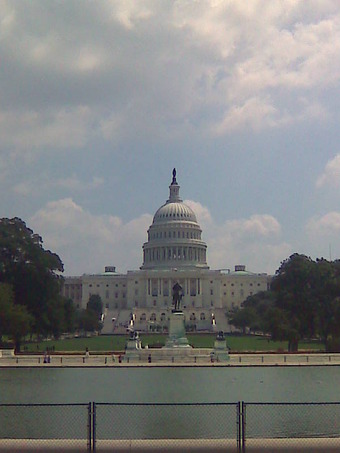
Capitol Hill
Capitol Hill, where bills become laws.
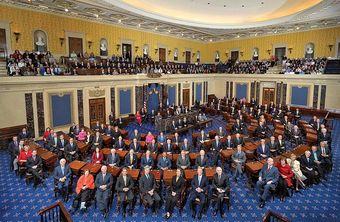
111th US Senate class photo
A class photo of the 111th United States Senate.
The U.S. House of Representatives has 435 members, elected for two year terms in single-seat constituencies. House of Representatives elections are held every two years on the first Tuesday after November 1 in even years, correlated with presidential elections. House elections are first-past-the-post elections that elect a Representative from each of 435 House districts which cover the United States. Special House elections can occur if a member dies or resigns during a term . The delegates of the territories of American Samoa, District of Columbia, Guam, the Northern Mariana Islands, Puerto Rico, and the U.S. Virgin Islands are also elected. The age of candidacy to be a Representative is 25.
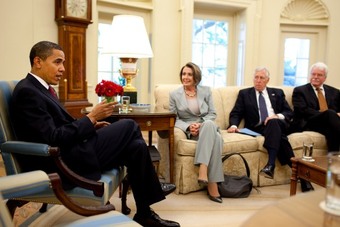
Barack Obama meets with Nancy Pelosi, Steny Hoyer & George Miller
President Barack Obama meets with Speaker Nancy Pelosi, House Majority Leader Steny Hoyer, and House Education and Labor Committee Chair Rep. George Miller, in the Oval Office Wednesday, May 13, 2009. House Energy and Commerce Committee Chair Rep. Henry Waxman, and House Ways and Means Committee Chair Rep. Charlie Rangel also attended the meeting but are not in the photo.
Qualifications in the House
Article I, Section 2 of the Constitution sets three qualifications for representatives. Each representative must (1) be at least twenty-five years old, (2) have been a citizen of the United States for the past seven years, and (3) be (at the time of the election) an inhabitant of the state they represent. Members are not required to live in the district they represent, but they traditionally do. The age and citizenship qualifications for representatives are less than those for senators. The constitutional requirements of Article I, Section 2 for election to Congress are the maximum requirements that can be imposed on a candidate. Therefore, Article I, Section 5, which permits each House to be the judge of the qualifications of its own members does not permit either House to establish additional qualifications. Likewise a State cannot establish additional qualifications.
Qualifications in the Senate
Article I, Section 3 of the Constitution sets three qualifications for senators: (1) they must be at least 30 years old, (2) they must have been citizens of the United States for at least the past nine years, and (3) they must be inhabitants of the states they seek to represent at the time of their election. The age and citizenship qualifications for senators are more stringent than those for representatives. In Federalist No. 62, James Madison justified this arrangement by arguing that the “senatorial trust” called for a “greater extent of information and stability of character. “
The Senate is the sole judge of a senator’s qualifications. During its early years, however, the Senate did not closely scrutinize the qualifications of its members. As a result, three senators who failed to meet the age qualification were nevertheless admitted to the Senate: Henry Clay (aged 29 in 1806), Armistead Thomson Mason (aged 28 in 1816), and John Eaton (aged 28 in 1818). Such an occurrence, however, has not been repeated since. In 1934, Rush D. Holt, Sr. was elected to the Senate at the age of 29; he waited until he turned 30 (on the following June 19) to take the oath of office. In 1972, Joe Biden was elected to the Senate shortly before his 30th birthday, but he reached his 30th birthday in time for the swearing-in ceremony for incoming senators in January 1973.
It is important to mention disqualification procedures in Congress. Under the Fourteenth Amendment, a federal or state officer who takes the requisite oath to support the Constitution, but later engages in rebellion or aids the enemies of the United States, is disqualified from becoming a representative. This post-Civil War provision was intended to prevent those who sided with the Confederacy from serving. However, disqualified individuals may serve if they gain the consent of two-thirds of both houses of Congress.
11.6.2: The Power of Incumbency
The incumbent is the existing holder of a political office who normally has a structural advantage over challengers during an election.
Learning Objective
Summarize the advantages the incumbents have in campaigns
Key Points
- The incumbent is the existing holder of a political office who normally has a structural advantage over challengers during an election for multiple reasons.
- A race without an incumbent is known as an open seat because of the lack of incumbency advantage and they are the most contested races in an election.
- The anti-incumbency factor is when incumbency leads to the downfall of the incumbent.
- An anti-incumbent vote is one exercised against elected officials currently in power.
Key Terms
- incumbency
-
the state of holding an office or title
- reapportionment
-
Reassignment of representation in a legislature, especially of U.S. House of Representative seats, in accord with changes in the census population determination.
The incumbent is the existing holder of a political office. It is usually used in reference to elections where races can often be defined as being between an incumbent and non-incumbents. Incumbents have structural advantages over challengers during elections. The percentage of incumbents who win reelection after seeking it in the U.S. House of Representatives has been over 80% for more than 50 years, and is often over 90%. Additionally, shifts in congressional districts due to reapportionment or other longer-term factors may make it more or less likely for an incumbent to win re-election over time. A race without an incumbent is referred to as an open seat because of the lack of incumbency advantage and they are the most contested races in an election.
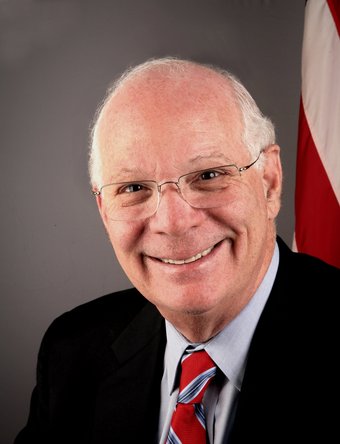
Longtime House Incumbent, Ben Cardin
Current Senator Ben Cardin was a longtime incumbent in the House of Representatives, serving from 1987 to 2007.
When newcomers vie to fill an open office, voters tend to compare and contrast the candidates’ qualifications, positions on issues and personal characteristics in a relatively straightforward way. Incumbents traditionally win their party’s nomination to run for office and unseating an incumbent during a primary elections is very difficult. The timing of elections may be determined by the incumbent instead of a set schedule. The incumbent often has more name recognition because of their previous work in the office they occupy. Incumbents have easier access to campaign finance and government resources that can be indirectly used to boost a campaign.
In general, incumbents have structural advantages over challengers during elections. The timing of elections may be determined by the incumbent instead of a set schedule. For most political offices, the incumbent often has more name recognition due to their previous work in the office. Incumbents also have easier access to campaign finance, as well as government resources (such as the franking privilege) that can be indirectly used to boost a campaign. An election (especially for a legislature) in which no incumbent is running is often called an open seat; because of the lack of incumbency advantage, these are often amongst the most hotly contested races in any election.
In the United States, incumbents traditionally win their party’s nomination to run for office. Unseating an incumbent president, senator or other figure during a primary election is very difficult, and even in the general election, incumbents have a very strong record. For instance, the percentage of incumbents who win reelection after seeking it in the U.S. House of Representatives has been over 80% for over 50 years, and is often over 90%.
However, there exist scenarios in which the incumbency factor itself leads to the downfall of the incumbent. Popularly known as the anti-incumbency factor, situations of this kind occur when the incumbent has proven himself not worthy of office during his tenure and the challenger demonstrates this fact to the voters. An anti-incumbent vote is one exercised against elected officials currently in power. It allows the voters to register their discontent with sitting government officials, particularly when protesting against certain actions taken by the government or the elected officials in question. An anti-incumbency factor can also be responsible for bringing down incumbents who have been in office for many successive terms in spite of performance indicators, simply because the voters are convinced by the challenger of a need for change. Nick Panagakis, a pollster, coined what he dubbed the “incumbent rule” in 1989—that any voter who claims to be undecided towards the end of the election will probably end up voting for the challenger.
Voters first have to consider the records and antecedents of the incumbent. Only if they decide to “fire” the incumbent do they begin to evaluate whether the challenger is an acceptable alternative. At the same time, if the challenger is determined to be completely unacceptable, voters might reluctantly vote for the incumbent. There are situations in which the incumbency factor leads to the downfall of the incumbent. This is known as the anti-incumbency factor. Situations of this kind occur when the incumbent has proven himself unworthy of the office during his tenure and the challenger convincingly demonstrates this fact to the voters. An anti-incumbency factor can also be responsible for voting out incumbents who have been in office for many successive terms in spite of performance indicators, simply because the voters are convinced by the challenger of a need for change.
11.6.3: Congressional Terms and Term Limits
Members of the Senate may serve unlimited six-year terms and members of the House may serve unlimited two-year terms.
Learning Objective
Summarize the attempts to impose term limits on Senators and Representatives
Key Points
- Under the Constitution, members of the United States Senate may serve an unlimited number of six-year terms and members of the House of Representatives may serve an unlimited number of two-year terms.
- In the 1990s, reformers put congressional term limits on the ballot and the main Republican Party platform was to pass legislation setting term limits in Congress.
- A proposed amendment limited members of the Senate to two six-year terms and members of the House to six two-year terms. The amendment was never passed.
Key Terms
- amendment
-
An addition to and/or alteration to the Constitution.
- referendum
-
A direct popular vote on a proposed law or constitutional amendment.
Congressional Terms and Term Limits
Under the Constitution, members of the United States Senate may serve an unlimited number of six-year terms and members of the House of Representatives may serve an unlimited number of two-year terms.

Capitol Hill
Capitol Hill, or the Capitol Building, houses the United States Congress.
Reformers during the early 1990s used referendums to put congressional term limits on the ballot in 24 states. Voters in eight of these states approved the congressional term limits by an average electoral margin of two to one. In the elections of 1994, part of the Republican platform was to pass legislation setting term limits in Congress. After winning the majority, they brought the constitutional amendment to the House floor. The amendment limited members of the Senate to two six-year terms and members of the House to six two-year terms. However, constitutional amendments require a two-thirds majority and the votes to impose term limits on Congress fell short of that number.
In May 1995, the United States Supreme Court ruled 5-4 in U.S. Term Limits, Inc. v. Thornton (1995). The ruling says that states cannot impose term limits on their federal Representatives or Senators. The U.S. Term Limits was the largest private organization pushing for Congressional term limits. Earlier that year, the Congress had given the Court assurance that the Justices would be acting only against state statutes, not overturning an act of Congress.The hopes of some that Congress would self-impose term limits had abruptly come to an end.
With the Republicans holding 230 seats in the House, three versions of the amendment got well under 200 votes, while the 12 year term-limits managed a bare majority in the House of 227-204, well short of the requisite two-thirds majority (290 votes) required to pass a constitutional amendment. Defeated in Congress and overridden by the Supreme Court, this populist uprising was brought to a halt for the purpose of reforming the federal government. The term limits intended simultaneously to reform legislatures remain in fifteen states.
In 2007, Professor Larry J. Sabato revived the debate over term limits by arguing in A More Perfect Constitution that the success and popularity of term limits at the state level suggests that they should be adopted at the federal level as well. He specifically put forth the idea of congressional term limits and suggested a national constitutional convention be used to accomplish the amendment, since the Congress would be unlikely to propose and adopt any amendment that limits its own power.
11.6.4: Candidates for Congressional Elections
Congressional elections determine the structure and makeup of the House of Representatives and Senate.
Learning Objective
Describe the relationship between House elections and the Presidential term cycle
Key Points
- The House of Representatives has 435 members, elected for a two year term in single-seat constituencies. House of Representatives elections are held every two years on the first Tuesday after November 1 in even years.
- House elections occur every two years, correlated with presidential elections or halfway through a President’s term. Typically, when a House election occurs in the same year as a presidential election, the party of the presidential winner will gain seats.
- An increasing trend has been for incumbents to have an overwhelming advantage in House elections, and since the 1994 election, an unusually low number of seats has changed hands in each election.
- The Senate has 100 members, elected for a six year term in dual-seat constituencies (2 from each state), with one-third being renewed every two years.
- Elections to the Senate are held on the first Tuesday after the first Monday in November in even-numbered years, Election Day, and coincide with elections for the House of Representatives. Senators are elected by their state as a whole.
Key Terms
- senate
-
The composition and powers of the Senate are established in Article I of the U.S. Constitution. Each U.S. state is represented by two senators, regardless of population. Senators serve staggered six-year terms. The chamber of the United States Senate is located in the north wing of the Capitol, in Washington, D.C., the national capital.
- house of representatives
-
The United States House of Representatives is one of the two houses of the United States Congress. The major power of the House is to pass federal legislation that affects the entire country, although its bills must also be passed by the Senate and further agreed to by the U.S. President before becoming law.
Example
- Due to gerrymandering, fewer than 10% of all House seats are contested in each election cycle. Over 90% of House members are reelected every two years, due to lack of electoral competition.
Congressional elections
Elections to Congress take place every two years. Congress has two chambers in Capitol Hill . Although the two-party system preserves the dominance of the Republican and Democratic parties, there is no direct relationship between congressional party discipline and election years. The support and backing of the parties is not necessary and sufficient to win elections. However, candidates no longer have a congressional party discipline like in other historical times.
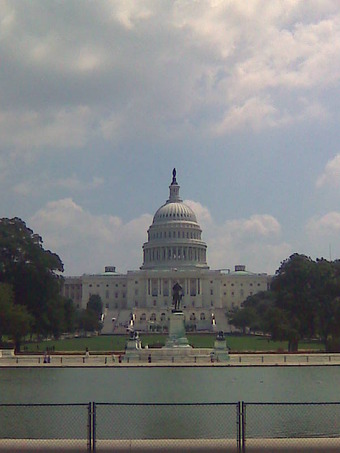
Capitol Hill
Capitol Hill, where bills become laws.
Senate elections
The Senate has 100 members, elected for a six year term in dual-seat constituencies (2 from each state), with one-third being renewed every two years. The group of the Senate seats that is up for election during a given year is known as a “class”; the three classes are staggered so that only one of the three groups is renewed every two years. Until the Seventeenth Amendment to the United States Constitution in 1913, Senators were elected by state legislatures, not the electorate of states.
Originally, senators were selected by the state legislatures, not by popular elections. By the early years of the 20th century, the legislatures of as many as 29 states had provided for popular election of senators by referendums. Popular election to the Senate was standardized nationally in 1913 by the ratification of the 17th Amendment.
Elections to the Senate are held on the first Tuesday after the first Monday in November in even-numbered years, Election Day, and coincide with elections for the House of Representatives. Senators are elected by their state as a whole. In most states, a primary election is held first for the Republican and Democratic parties, with the general election following a few months later. Ballot access rules for independent and minor party candidates vary from state to state. The winner is the candidate who receives a plurality of the popular vote. In some states, runoffs are held if no candidate wins a majority.
House of Representatives Elections
The House of Representatives has 435 members, elected for a two year term in single-seat constituencies. House of Representatives elections are held every two years on the first Tuesday after November 1 in even years. House elections are first-past-the-post elections that elect a Representative from each of 435 House districts which cover the United States. Special House elections can occur between if a member dies or resigns during a term. The delegates of the territories of American Samoa, District of Columbia, Guam, the Northern Mariana Islands, Puerto Rico and the United States Virgin Islands are also elected.
House elections occur every two years, correlated with presidential elections or halfway through a President’s term. Typically, when a House election occurs in the same year as a presidential election, the party of the presidential winner will gain seats. On the other hand, there is a historical pattern that the incumbent president’s party loses seats in elections that are held in the middle of a presidential term. This may be because the President’s popularity has slipped since election, or because the President’s popularity encouraged supporters to come out to vote for him in the presidential election, but these supporters are less likely to vote when the President is not up for election.
As the redistricting commissions of states are often partisan, districts are often drawn which benefit incumbent . An increasing trend has been for incumbents to have an overwhelming advantage in House elections, and since the 1994 election, an unusually low number of seats has changed hands in each election. Due to gerrymandering, fewer than 10% of all House seats are contested in each election cycle. Over 90% of House members are reelected every two years, due to lack of electoral competition. Gerrymandering of the House, combined with the divisions inherent in the design of the Senate and of the Electoral College, result in a discrepancy between the percentage of popular support for various political parties and the actual level of the parties’ representation.

US House Balance OverTime
Chart shows the percentage of the United States House of Representatives held by various parties from 1789 until 2004. (as elected in the biennial elections) Occasionally terms are applied in a slightly anachronistic way, such as for Federalists and Democratic-Republicans in the first few years on the Congress, or for Whigs during Jackson’s presidency. Notable features include the near absence of minor parties, and the narrowness of the current majority by historical standards.
2016 Congressional Elections
A total of 469 seats in the U.S. Congress (34 Senate seats and all 435 House seats) are up for election on November 8, 2016.
The big questionof the 2016 congressional election cycle is whether or not the Democratic Party will be able to regain control of the Senate. In order to take the chamber back, Democrats will need to gain five seats in 2016. The majority of vulnerable seats are held by Republican incumbents, many of whom are freshmen who were swept into office in the Republican wave of 2010. Additionally, Democrats only have 10 seats to defend in 2016, while 24 Republican incumbents are up for re-election.
11.7: How Congressmen Decide
11.7.1: Political Parties
Political parties serve to coordinate, assist and provide resources for members of congress and political candidates.
Learning Objective
Describe the history of political parties and their role in Congress
Key Points
- Political parties are one of the most enduring political institutions in the US, and with recent increases in the partisan nature of congress political parties are playing a increased role in US democracy.
- There is little mention of political parties in the US constitution, or any other founding documents, and many of the country’s founder opposed political parties expecting them to be divisive.
- In congress political parties serve to coordinate, assistant and provide resources for members of congress and political candidates.
- Since the 1990s there has been a stronger control by congressional party leaders on individual members including higher rates of party voting. Members of congress now routinely vote with their party at rates as high as 60 or 70 percent.
- The increase in party power also means that bipartisan collaboration between members of congress is less likely.
Key Terms
- caucus
-
A meeting, especially a preliminary meeting, of persons belonging to a party, to nominate candidates for public office, or to select delegates to a nominating convention, or to confer regarding measures of party policy; a political primary meeting.
- bipartisan
-
relating to, or supported by two groups, especially by two political parties
- party voting
-
The type of voting that describes when voters cast their vote based on their self-identification with a particular political party.
Political Parties
Political parties are one of the most enduring political institutions in the US, and with recent increases in the partisan nature of congress political parties are playing a increased role in US democracy.
Political parties are one of the main coordinating bodies in Congress. With hundreds of individual members the party’s caucus or conference helps to bring together like-minded politicians and constituents, coordinate election efforts, set legislative priorities, and determine who will receive important committee appointments.
History of Political Parties
The Democrat and Republican parties have dominated the political landscape in the US for quite some time now. However, this has not always been the case, and the current political parties have also changed significantly over this time.
There is little mention of political parties in the US constitution, or any other founding documents. Many of the country’s founder opposed political parties, expecting them to be divisive. However, by the 1790s two parties the Federalists and Republicans had been established. These parties were separated by preferences for either a strong or weak central government.
Each of today’s major parties have made various changes throughout their existence, even as their name may have remained the same. For example it was a Republican-led congress that initiated the Civil War amendments that officially outlawed slavery in the US and gave citizenship and voting rights to formerly enslaved people and their ancestors. However, by the 1960s in was Democratic politicians who moved forward Civil Rights legislation. Today we are seeing another shift in the Republican Party with the increased influence of the Tea Party social movement within the leadership of the party.
Political Parties in Congress
In Congress political parties serve to coordinate, assistant and provide resources for members of congress and political candidates. Parties control primary elections which are the main means through which candidates can get on ballots. They also control committee appointments, and since the 1990s there has been a stronger control by congressional party leaders on individual members including higher rates of party voting. Members of congress now routinely vote with their party at rates as high as 60 or 70 percent. In addition to increasing the power of party leadership it means that bipartisan collaboration between members of congress is less likely.
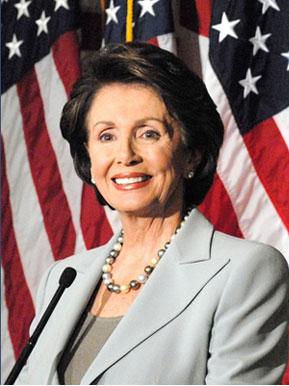
Nancy Pelosi
Nancy Pelosi is the leader of the House Democrats and the first women to be Speaker of the House.
This rise in party power also means that the experiences of members of the majority versus minority party will be quite different. Majority party members will have many positive powers to pass legislation to support their own ideology and constituencies. However, minority party members will have to rely on negative powers such as blocking legislation in committees, or using filibuster techniques.
Coalitions
To deal with a situation in which no clear majorities appear through general elections, parties either form coalition cabinets, supported by a parliamentary majority, or minority cabinets which may consist of one or more parties. Cabinets based on a coalition with majority in a parliament, ideally, are more stable and long-lived than minority cabinets. While the former are prone to internal struggles, they have less reason to fear votes of non-confidence. Majority governments based on a single party are typically even more stable, as long as their majority can be maintained.
Coalition cabinets are common in countries in which a parliament is proportionally representative, with several organized political parties represented. It usually does not appear in countries in which the cabinet is chosen by the executive rather than by a lower house, such as in the United States (however, coalition cabinets are common in Brazil). In semi-presidential systems such as France, where the president formally appoints a prime minister but the government itself must still maintain the confidence of parliament, coalition governments occur quite regularly. In the United States, political parties are best described as coalitions.
11.7.2: Constituency
Each member of Congress has a responsibility to their constituents because they decide if a congressional member will be re-elected.
Learning Objective
Identify the rules and duties of members of Congress while they are in office, and the factors that shape how they vote on bills
Key Points
- Each member of the U.S. Congress is elected by voters in their home district. These voters are members of Congress’ constituency.
- Each member has a special responsibility to their constituents because these are the only voters who get to decide if a congressional member will be re-elected.
- Districts are reevaluated after each 10 year census and redrawn as needed to adjust to population changes. However, this is not a completely neutral process. The practice of gerrymandering has been used to insure that one party or the other will have an easier time winning elections.
- All members of Congress maintain constituency offices which are home bases where staff can keep in touch with local concerns, activists, and interests.
- Members of Congress also attempt to maintain support with constituency members by using their influence in Congress to gain support for local projects such as new, lucrative construction projects.
Key Terms
- pork barrel
-
The appropriation of government spending for localized projects secured solely or primarily to bring money to a representative’s district
- gerrymandering
-
The practice of redrawing electoral districts to gain an electoral advantage for a political party.
Constituency
Each member of the U.S. Congress is elected by voters in their home district. These voters are a part of congress’ constituency. Each congressional member has a special responsibility to their constituents because these are the only voters who get to decide if a member will be re-elected.
Models of Representation: The Delegate vs. Trustee Model
Representatives can act in two models of representation: as delegates or trustees. The delegate model of representation is a model of a representative democracy. In this model, constituents elect their representatives as delegates for their constituency. These delegates act only as a mouthpiece for the wishes of their constituency, and have no autonomy from the constituency. This model does not provide representatives the luxury of acting in their own conscience. Essentially, the representative acts as the voice of those who are (literally) not present.
On the other hand, the trustee model of representation is a model for how we should understand the role of representatives, and is frequently contrasted with the delegate model of representation. Constituents elect their representatives as ‘trustees’ (or ‘entrust’ them) for their constituency. These ‘trustees’ have sufficient autonomy to deliberate and act in favor of the greater common good and national interest, even if it means going against the short-term interests of their own constituencies. The model provides a solution to the problem of uninformed constituents who lack the necessary knowledge on issues to take an educated position. By contrast in the delegate model, the representative is expected to act strictly in according to a mandate from the represented.
House of Representatives Districts
Members of the House of Representatives are elected to represent districts that range in size from the 905,316 people representing the entire state of Montana to 495,304 which represents the entire state of Wyoming. Most states have multiple representatives.
Districts are generally reevaluated after each 10 year census. The districts are redrawn as needed to adjust to population changes. However, this is not a completely neutral process. The practice of gerrymandering has been used to insure that one or the other party will have an easier time winning elections by creating districts that hold a majority of voters likely to vote for one party or the other. Looking at the maps of congressional districts it is obvious that some districts are far from uniform. The more complicated shapes on the map might be a result of gerrymandering.
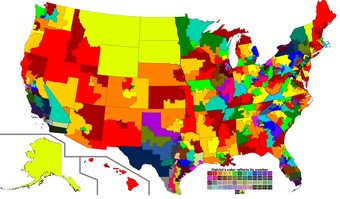
U.S. Congress House Districts
This map shows the boundaries for the U.S. Congress housing districts.
Senate Seats
U.S. Senators simply represent their states. There are two senators per state. Therefore, the constituency in smaller states such as Wyoming might be able to gain disproportionate influence.
Local Concerns
All members of congress maintain constituency offices, which are home bases where staff can keep in touch with local concerns, activists, and interests. Members of Congress will pay a great deal of attention to their constituency’s concerns. Congressional members will often attempt to maintain support with constituency members through practices such as pork barrel politics. This practice is when members will use their influence in Congress to gain support for local projects such as new lucrative construction projects.
11.7.3: Interest Groups, Lobbyists, and PACs
Interest groups attempt to influence Members of Congress in a variety of ways, such as lobbying and financing campaigns using PACs.
Learning Objective
Describe how outside groups work to shape policy at the federal level through the use of interest groups, lobbyists, and PACs.
Key Points
- Interest group represent people or organizations with common concerns and interests. These groups work to gain or retain benefits for their members, through advocacy, public campaigns, and even lobbying governments to make changes in public policy.
- Interest groups may take on a variety of strategies including public education, encouraging public participation, and providing education and special information for civil servants and politicians.
- Interest groups are also involved in actives such as lobbying to directly persuade decision makers in Congress along with members of the executive branch.
- PACs are organized groups that work on election campaigns both for specific parties and ballot initiatives. These groups pool donations to redistribute to candidates, parties and other PACs.
- Super PACs can also spend unlimited amounts of money advocating for or against a candidate or issue, but may not donate to, or coordinate with, a particular campaign.
Key Term
- lobbyist
-
A person remunerated to persuade (to lobby) politicians to vote in a certain way or otherwise use their office to effect a desired result.
Interest Groups, Lobbyists, and PACs
Interest groups represent people or organizations with common concerns and interests. These groups work to gain or retain benefits for their members through advocacy, public campaigns, and lobbying governments to make changes in public policy. There are a wide variety of interest groups representing a variety of constituencies including business, labor, consumers, other governments, and various single issue groups.
Interest groups may take on a variety of strategies including public education, encouraging public participation, and providing education and special information for civil servants and politicians. However, interest groups are also involved in activities such as lobbying and forming PACs, which has led to concerns that some groups and even individuals might have disproportionate influence on Congress.
Lobbyists
There are over twelve thousand registered lobbyists in Washington, but only a handful of those have the influence and connections needed to consistently influence policy. Lobbyists work for a wide variety of groups, ranging from individual companies and non-profit organizations, to other governments and large coordinated councils representing whole industries, labor movements, or consumers. Lobbyists work to directly persuade decision makers in Congress along with members of the executive branch.
The impact of lobbyists is unclear, but many believe they can influence public policy. One example is the strength and influence of the National Rifle Association (NRA), who are advocates for gun rights. They also oppose gun regulations and legislation that infringe on the privacy of gun owners in the United States, who has one of the most lenient gun regulations in the Global North.
Political Action Committees (PACs)
PACs are organized groups that work on election campaigns often on behalf of specific parties and ballot initiatives. These groups pool donations to redistribute to candidates, parties, and other PACs. Federal Election Commission (FEC) regulations limit the amount of money PACs can donate to any one campaign or party, and there are limits to the amount of money they can receive from any one donor.
PACs can be connected to existing organizations such as business, labor or trade organizations or non-connected, usually rallying around a single issue or ideology.
While PACs have existed since the 1940s, the 2010 SpeechNow.org v. Federal Election Commission decision of the Supreme Court created a new form of PAC. They are officially known as independent expenditure-only committees, but better known as Super PACs . These groups can raise money without limits in from individuals, organizations, and large donors such as corporations or labor unions. Super PACs can also spend unlimited amounts of money advocating for or against a candidate or issue, but may not donate to, or coordinate with, a particular campaign.

Stephen Colbert
Political satirist Stephen Colbert has started his own Super PAC to draw attention to these organizations.
The SpeechNow.org case built on the decision in the Citizens United v. Federal Election Commission case earlier in 2010, which held that the First Amendment right to free speech meant that legislatures could not limit independent political spending by corporations and unions.
The 2012 election cycle is the first presidential election to be held under the new rules. Before the campaigns even ended, the Super PACs had outspent the top ten PACs from 2008 by at least tenfold. A large majority of Super PAC donations also come from wealthy individual donors. By October 2012, the top 100 individual Super PAC donors donated 80% of all Super PAC funds, yet made up fewer than 4% of all donors.
Information and Watchdogs
Critics of Super PACs are concerned that these groups can, in effect, “buy” elections. If elected, the candidates may then feel a special obligation to these wealthy donors and organizations. Several groups now exist to track the connections between Members of Congress, lobbyists, and campaign financing. Some of these groups include the Center for Responsive Politics and the OpenCongress.org website.
11.7.4: Switching Parties
Though uncommon, a member of Congress switch parties for either ideological or pragmatic reasons.
Learning Objective
List several well-known cases of senators switching parties
Key Points
- Political parties provide various benefits to Members of Congress and so it is fairly uncommon for a Member of Congress to cross over parties.
- Some Members might cross over due to ideological differences with their party, or more pragmatic reasons such as power gain or reelection in the Senate.
- Various politicians who have crossed parties have found both success and failure.
Key Term
- primary
-
A primary election; a preliminary election to select a political candidate of a political party.
Crossing Over of Parties
Political Parties provide various benefits to Members of Congress, including some election support, support in Congress, and positions on various committee. Political parties also serve as ideological homes for Members, and voters are often more attached to a party than to any given candidate. For these reasons, it is fairly uncommon for a Member of Congress to cross over parties, but it is not unheard of.
A member might switch parties, or “cross the floor,” for a number of reasons. Some members might switch due to ideological differences with their party. This was the case with Senator Strom Thurmond who, in 1964, switched from the Democratic to Republican party in opposition to the Civil Rights Bills. Others switch for more pragmatic reasons, such as to gain more power in Congress or to gain reelection. Richard Shelby, a relatively conservative Democrat Senator switched to the Republican Party in 1994 after they gained a majority in the Senate, and went on receive high profile committee appointments.
Crossing over can cause difficulties. For example, when Ben Nighthorse Campbell crossed to the Republican party after being elected as a Democratic Senator, much of his Congressional staff quit. Others who have crossed over have found success: Senator Joe Lieberman served as a Democrat and even ran as the Democratic Vice Presidential nominee in 2000, but after losing the Democratic primary in his home state of Connecticut, ran and was elected as an Independent. He eventually supported the 2008 Republican presidential ticket.
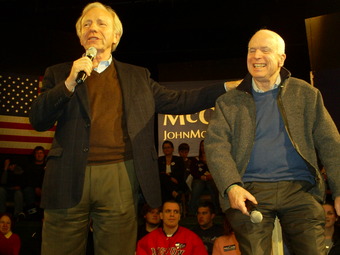
Joe Lieberman and John McCain
Senator Lieberman was a Democrat, then crossed over as an Independent, then endorsed a Republican presidential candidate.
